Lecture 10: Intellectual and Neuropsychological Assessment
1/51
Earn XP
Description and Tags
By Jordana Burstein for Clinical Psychology
Name | Mastery | Learn | Test | Matching | Spaced |
|---|
No study sessions yet.
52 Terms
Three types of tests (Intellectual and Neuropsychological Assessment)
Intelligence
Aptitude or Intellect
Intelligence Tests
Achievement
Achievement Tests
Neuropsychological
Aptitude or intellect (Intellectual and Neuropsychological Assessment)
The exact definition has long been a subject of debate among psychologists. May or may not include:
Speed of mental processing, sensory capacity, abstract thinking, imagination, adaptability, capacity to learn through experience, memory, reasoning, or inhibition of instinct
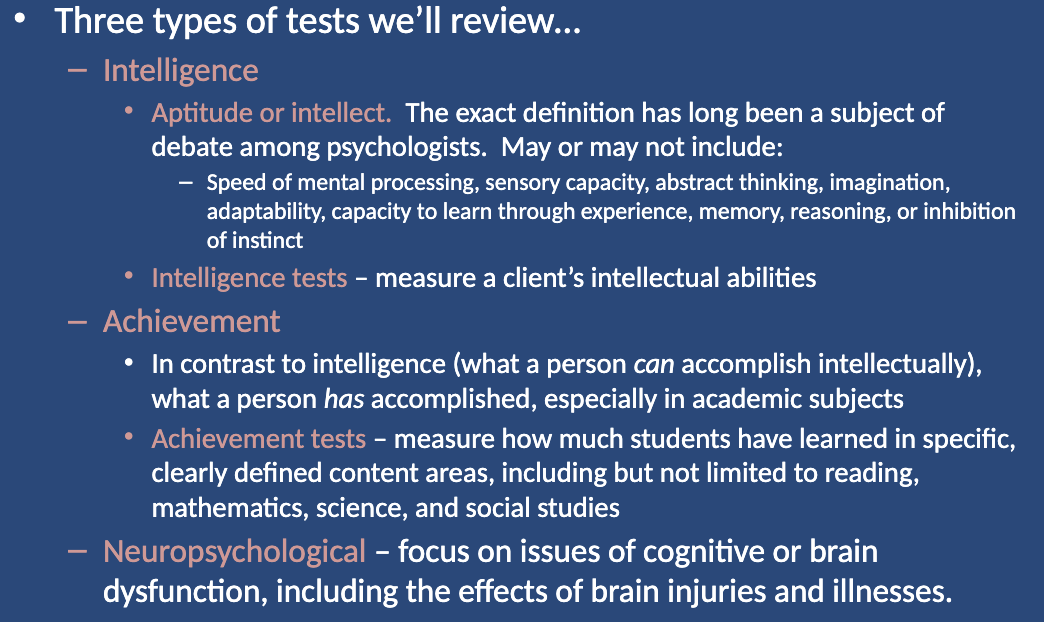
Intelligence tests (Intellectual and Neuropsychological Assessment)
measure a client’s intellectual abilities
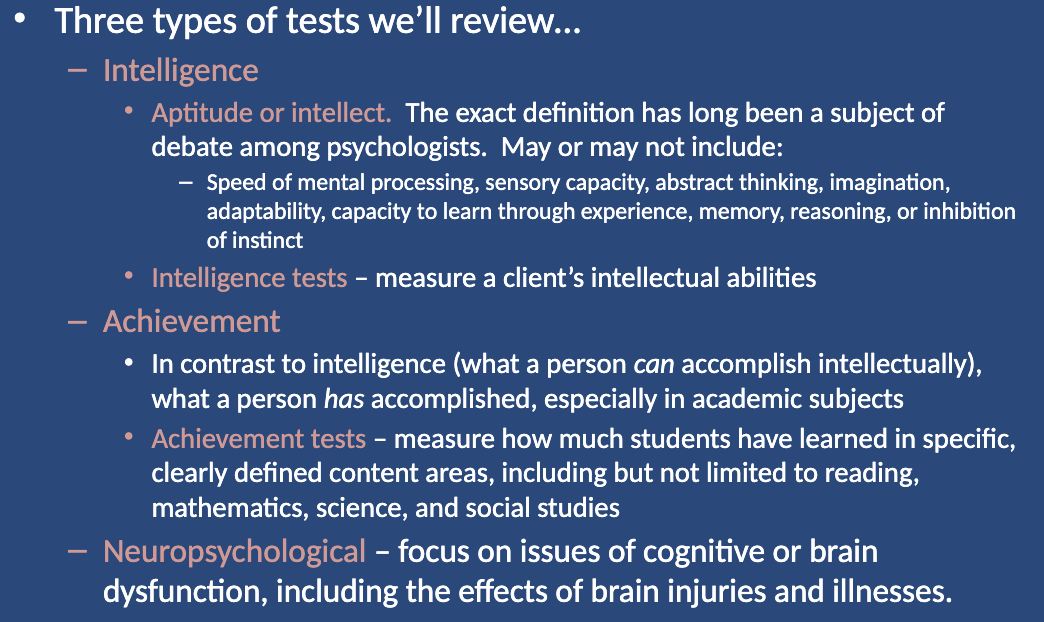
Achievement (Intellectual and Neuropsychological Assessment)
In contrast to intelligence (what a person can accomplish intellectually), what a person has accomplished, especially in academic subject
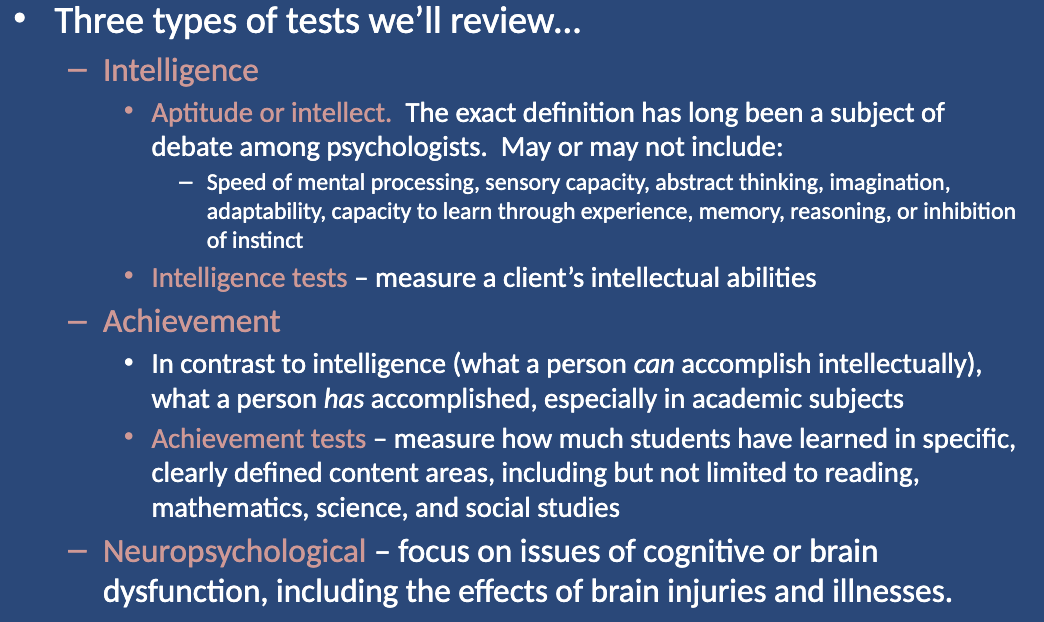
Achievement Tests (Intellectual and Neuropsychological Assessment)
measure how much students have learned in specific, clearly defined content areas, including but not limited to reading, mathematics, science, and social studie
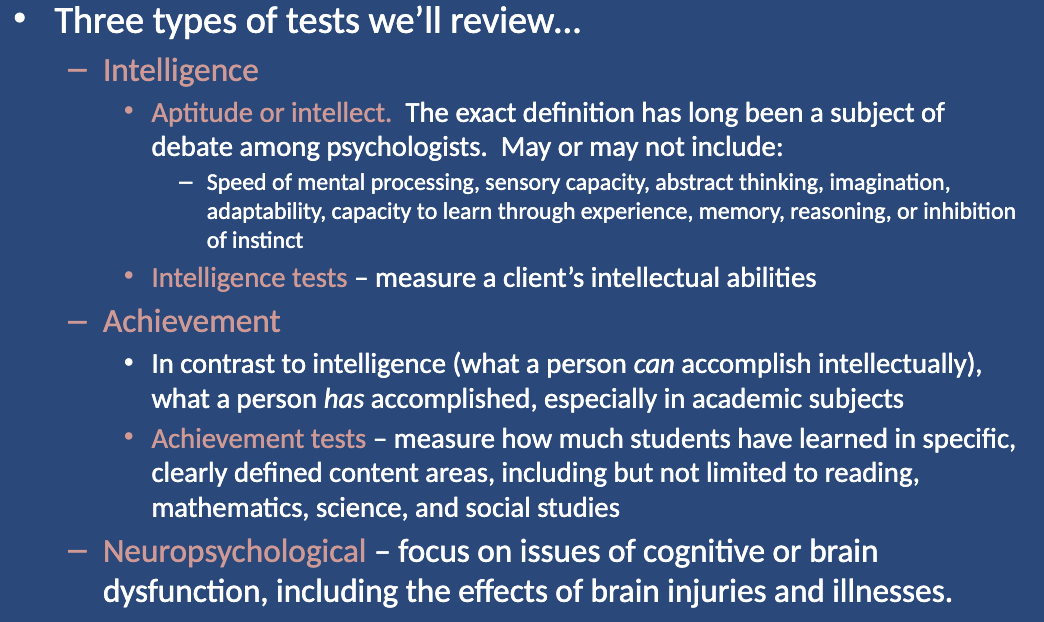
Neuropsychological (Intellectual and Neuropsychological Assessment)
focus on issues of cognitive or brain dysfunction, including the effects of brain injuries and illnesses
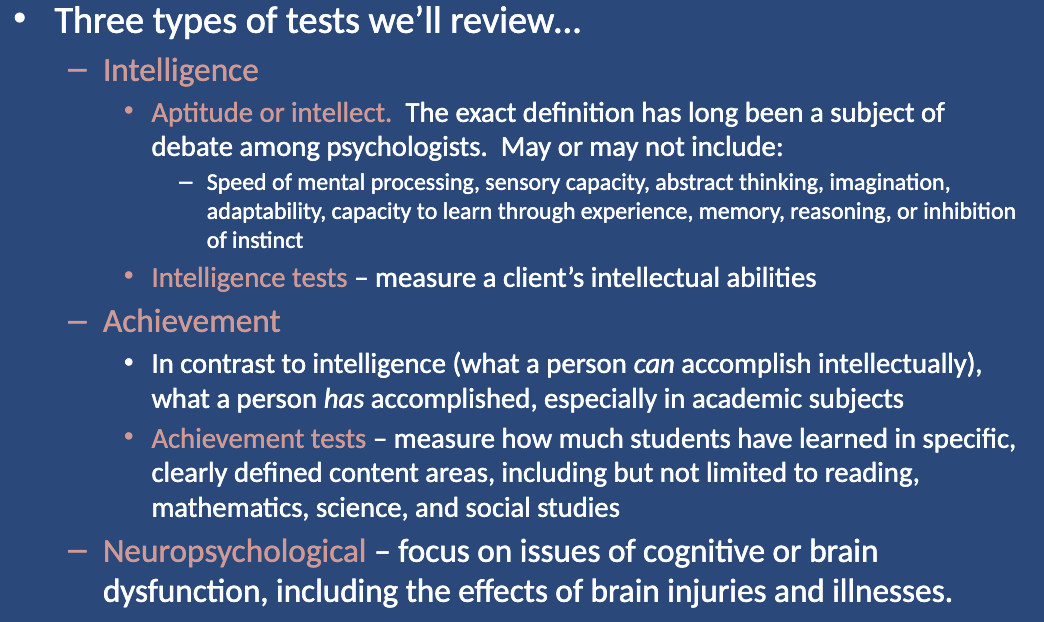
What is Gottfredson's definition of intelligence (1997)? (Intelligence)
Gottfredson defines intelligence as the ability to direct one’s thinking, adapt to circumstances, and learn from experiences.

What is Pinker's definition of intelligence (1997)? (Intelligence)
Pinker defines intelligence as the ability to attain goals in the face of obstacles through decisions based on rational (truth-obeying) rules.
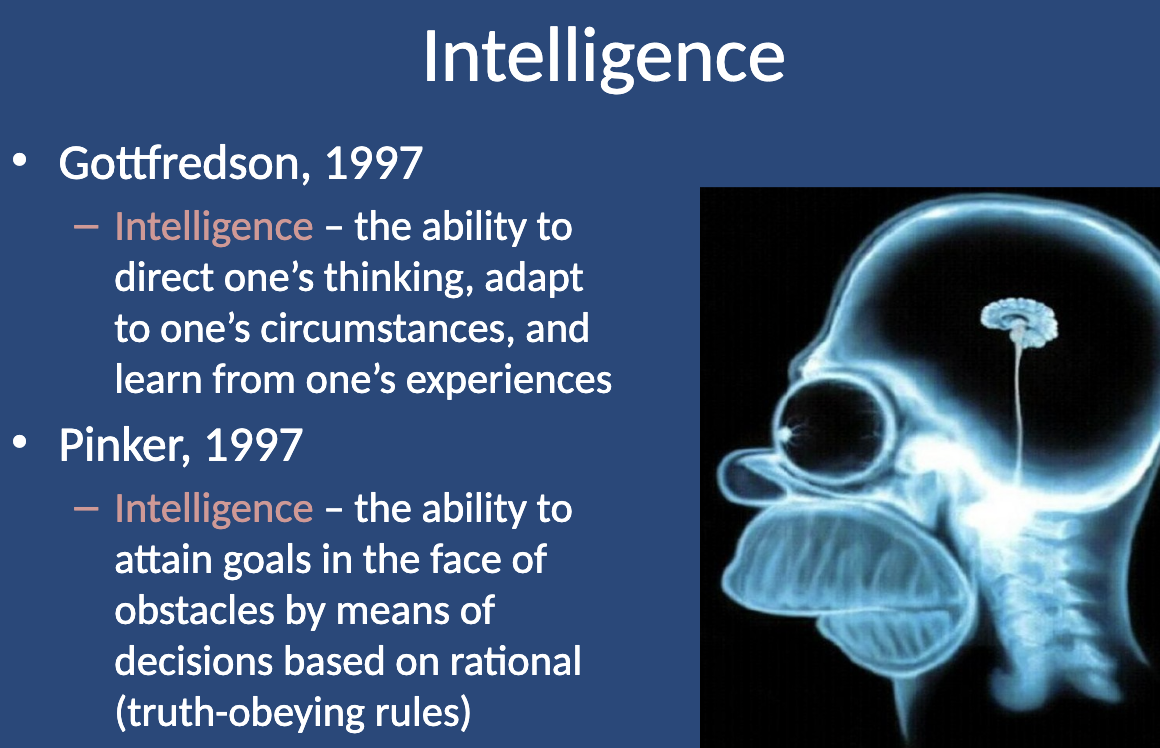
What is the main debate in intelligence testing? (Intelligence)
The main debate in intelligence testing is whether intelligence is one thing or many things. This question has received the most attention in the field.
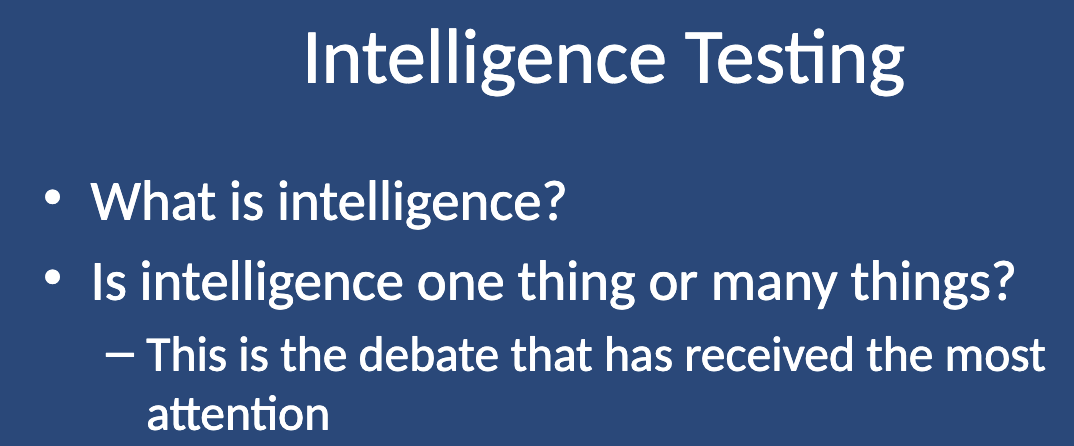
What was Charles Spearman’s theory of intelligence? (Intelligence: Spearman)
Spearman believed intelligence was a single characteristic, which he labeled “g” for general intelligence.
Argued that “g” represented a person’s global intellectual ability
His theory was based on research showing a strong correlation between a wide range of abilities, suggesting a single factor underlies them all.
He acknowledged specific abilities (labeled "s") exist, but argued they played a minor role in intelligence.
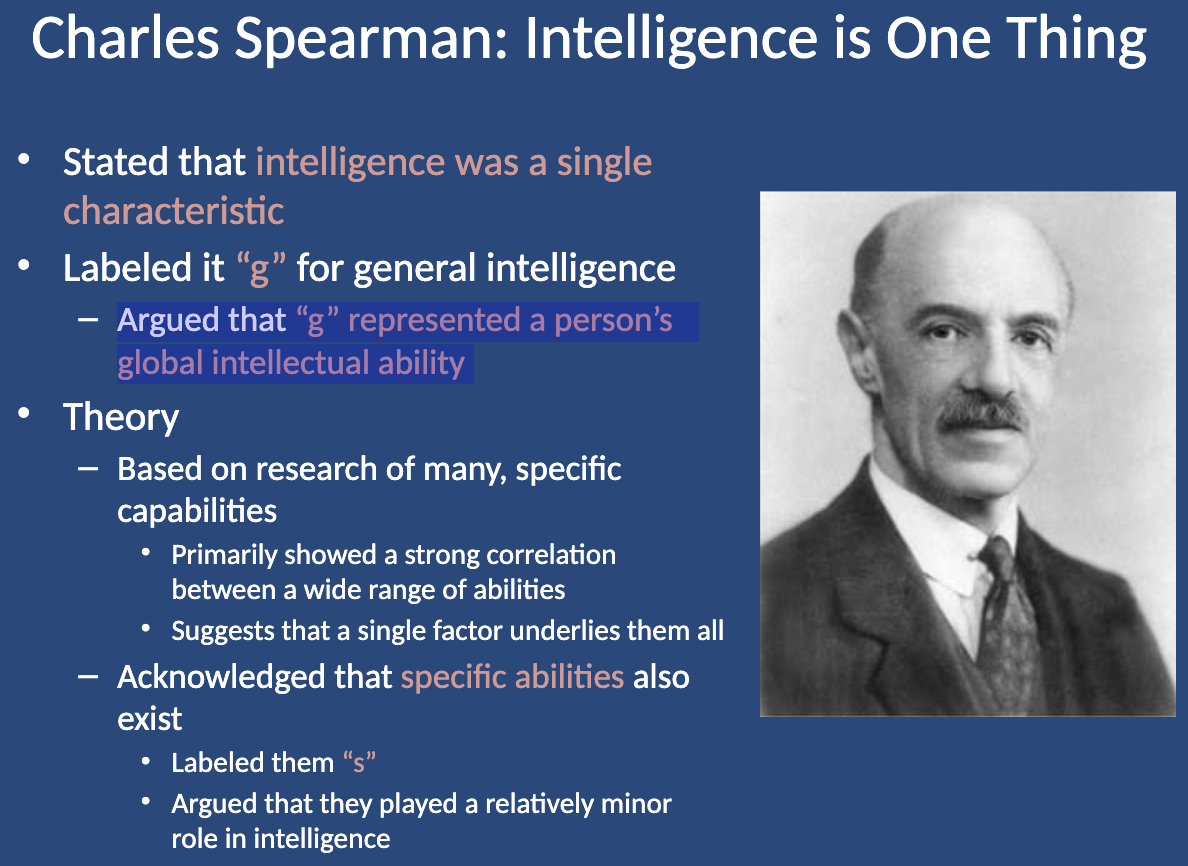
What does “g” stand for? (Intelligence: Spearman)
General intelligence; represented a person’s global intellectual ability
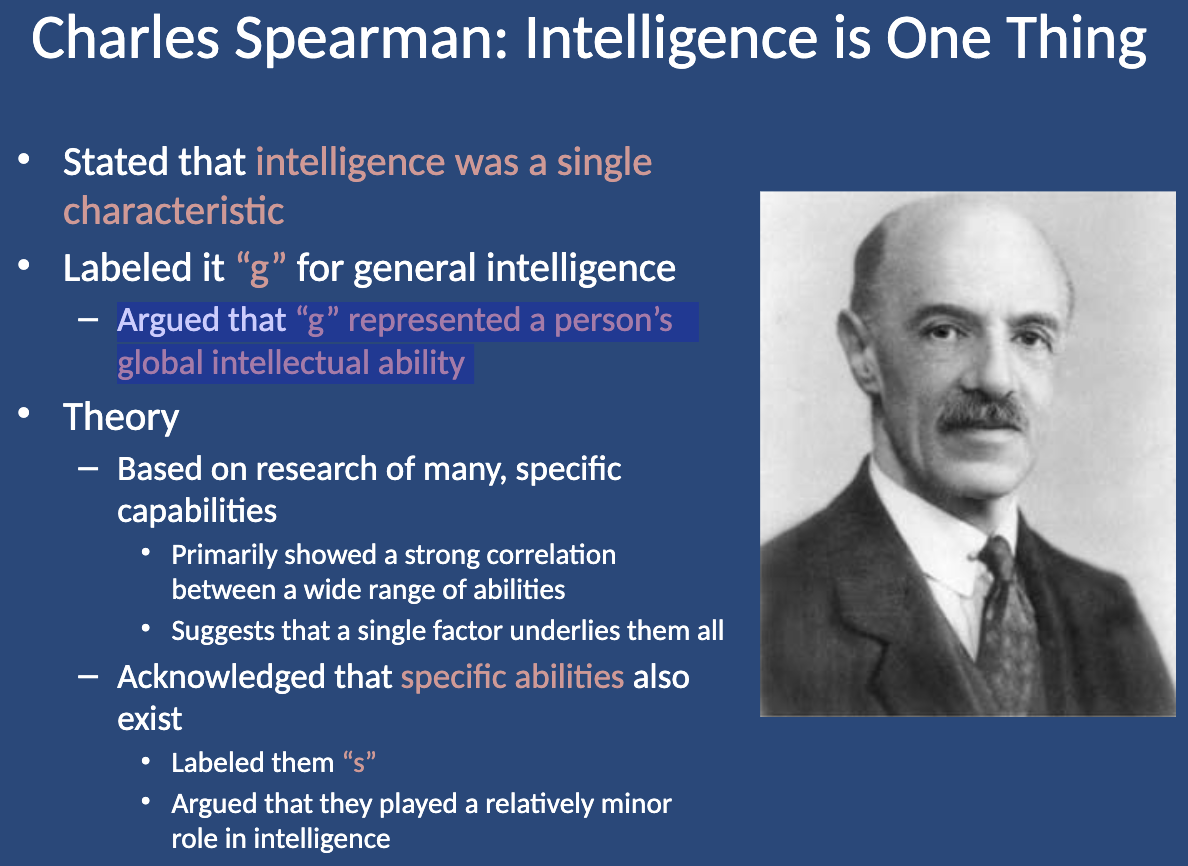
What does “s” stand for? (Intelligence: Spearman)
Specific abilities; Spearman argued that they played a minor role in intelligence.
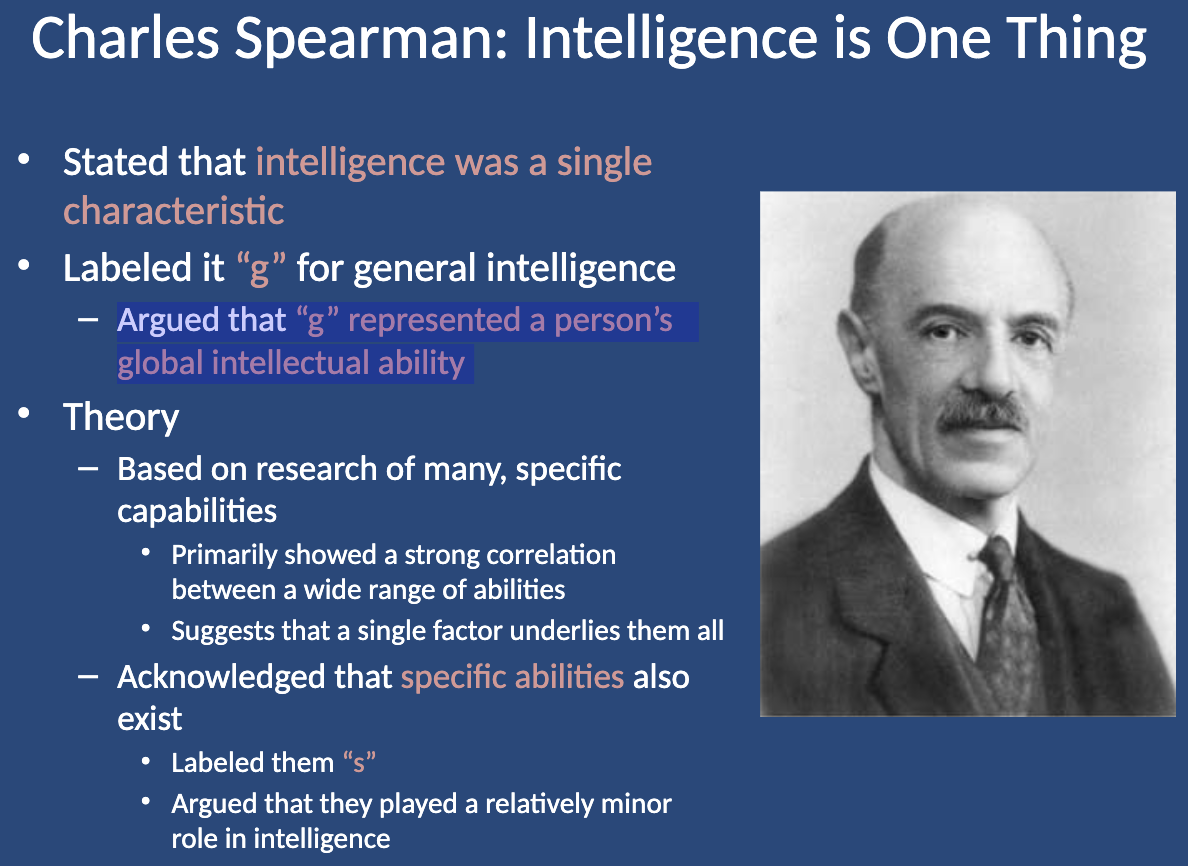
What was Louis Thurstone’s theory of intelligence? (Intelligence: Thurstone)
Thurstone believed intelligence consists of numerous distinct abilities with little relationship to one another.
He pioneered multiple factor analysis, identifying several independent factors, with labels such as verbal comprehension, numerical ability, spatial reasoning, and memory.
Thurstone argued that knowing someone's ability in one skill doesn’t allow you to predict their ability in another skill.
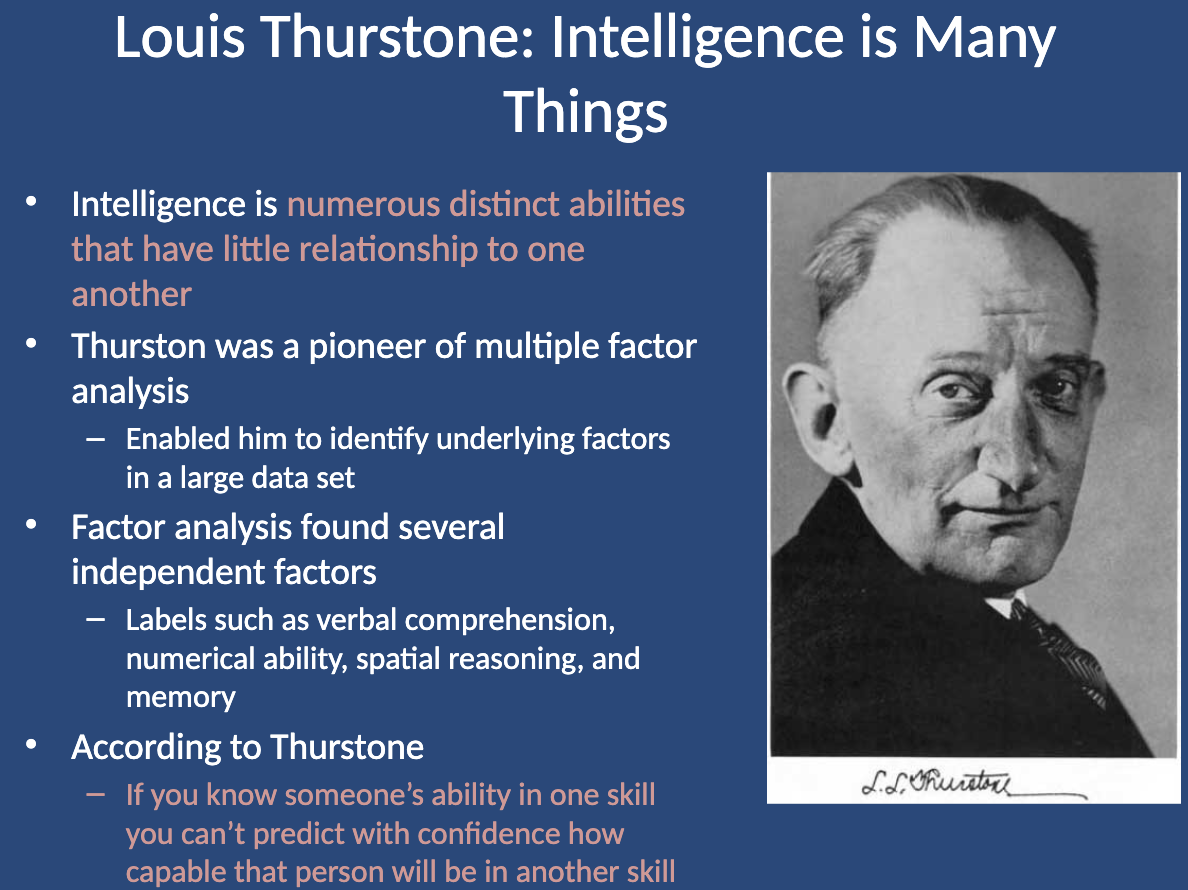
What is the hierarchical model of intelligence? (Intelligence)
The hierarchical model of intelligence is a compromise between Spearman and Thurstone’s theories.
They agreed that:
Specific abilities (“s”) exist and are important, but they are all somewhat related to:
One another
A global, overall, general intelligence (“g”)
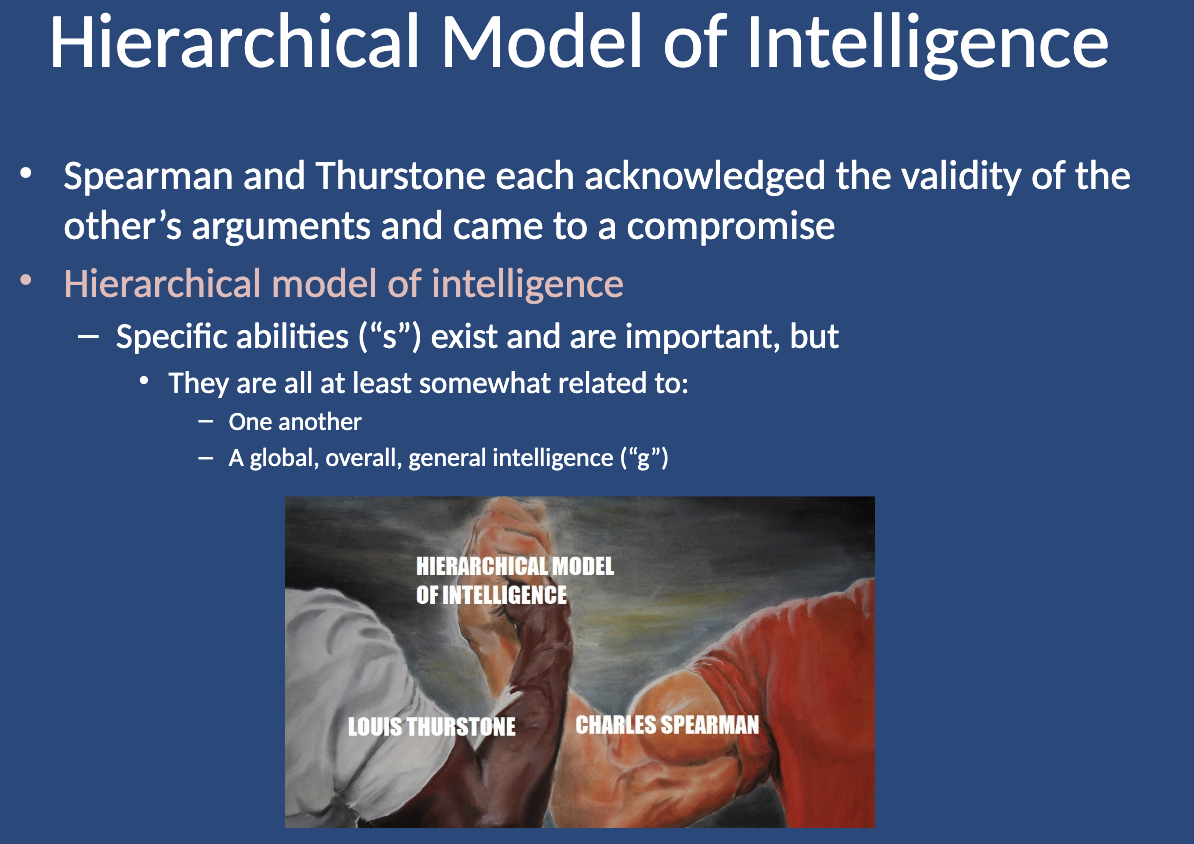
What was James Cattell’s two type theory of intelligence? (Intelligence: Cattel)
James Cattell proposed two separate intelligences:
Fluid Intelligence: The ability to reason when faced with novel problems.
Crystallized Intelligence: The body of knowledge accumulated through life experiences.
These theories fall somewhere between Spearman’s theory of singular intelligence and Thurstone’s theory of many intelligences.
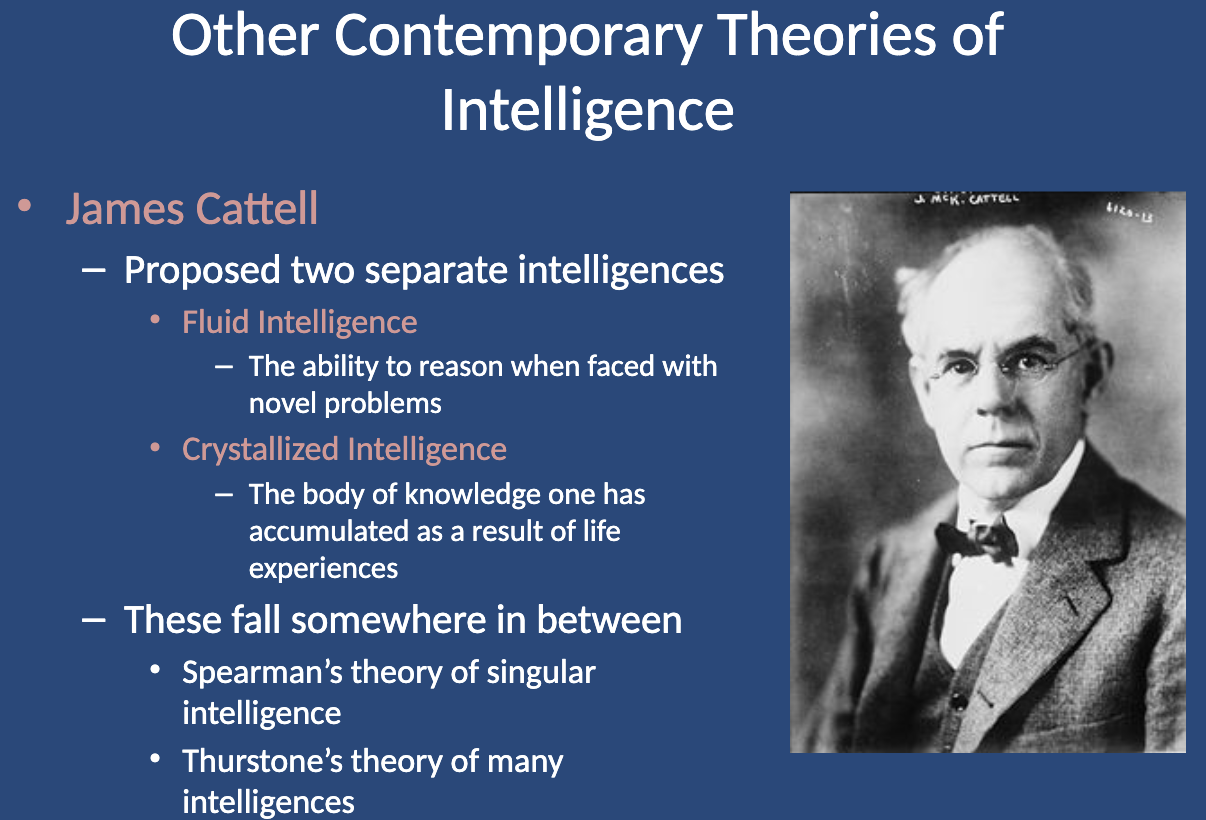
Fluid Intelligence (Intelligence: Cattell)
The ability to reason when faced with novel problems
and adapt to new situations.
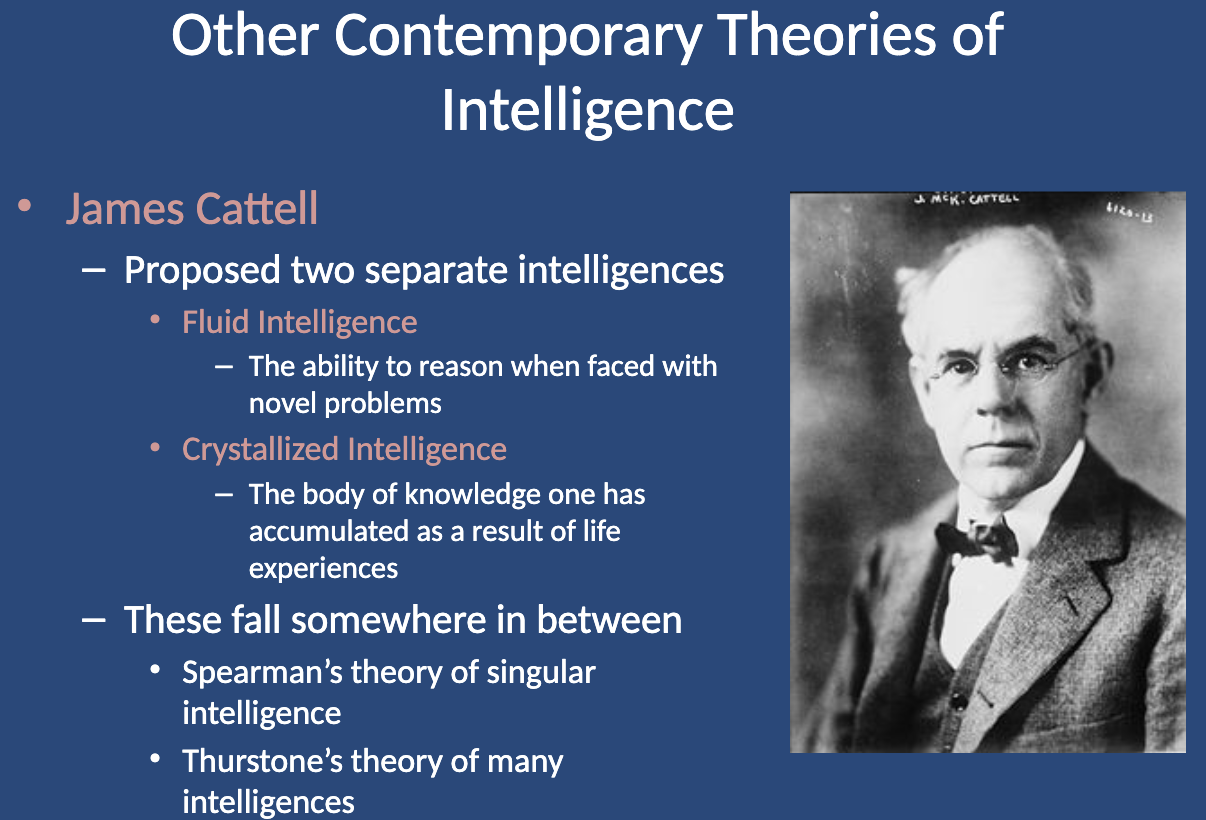
Crystallized Intelligence (Intelligence: Cattell)
The body of knowledge one has accumulated as a result of life experiences
and education, which tends to improve with age.

What is John Carroll’s Three-Stratum Theory of Intelligence? (Intelligence)
John Carroll’s Three-Stratum Theory of Intelligence posits that intelligence operates at three levels:
A single “g” at the top (general intelligence).
Eight broad factors immediately beneath “g.”
More than 69 highly specific abilities beneath these broad factors.
Most psychologists align with this view, though they may propose fewer specific abilities.
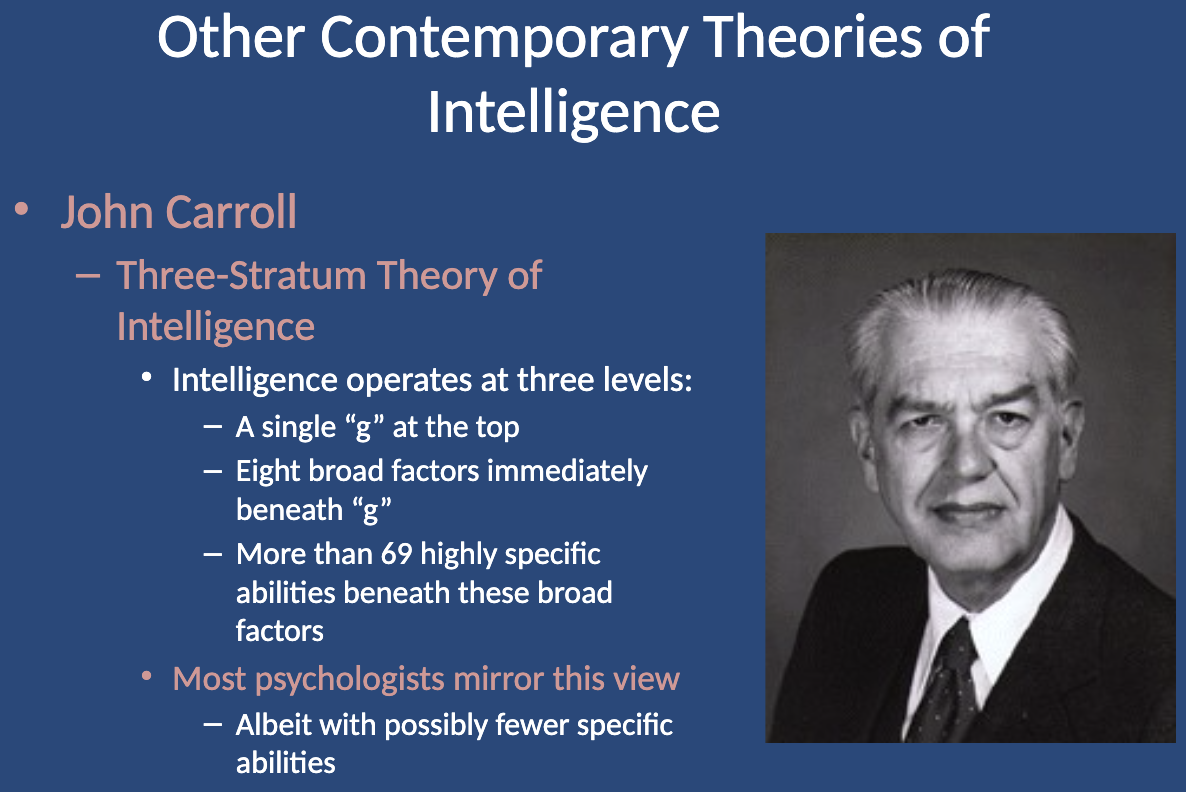
What are the Wechsler Intelligence Tests?(Intelligence: Wechsler)
David Wechsler authored three separate intelligence tests, each highly respected among clinical psychologists for its respective age range:
WAIS-IV: Wechsler Adult Intelligence Scale – Fourth Edition.
WISC-V: Wechsler Intelligence Scale for Children – Fifth Edition.
WPPSI-IV: Wechsler Preschool and Primary Scale of Intelligence – Fourth Edition.
These tests cover virtually the entire lifespan and vary slightly but share fundamental characteristics.
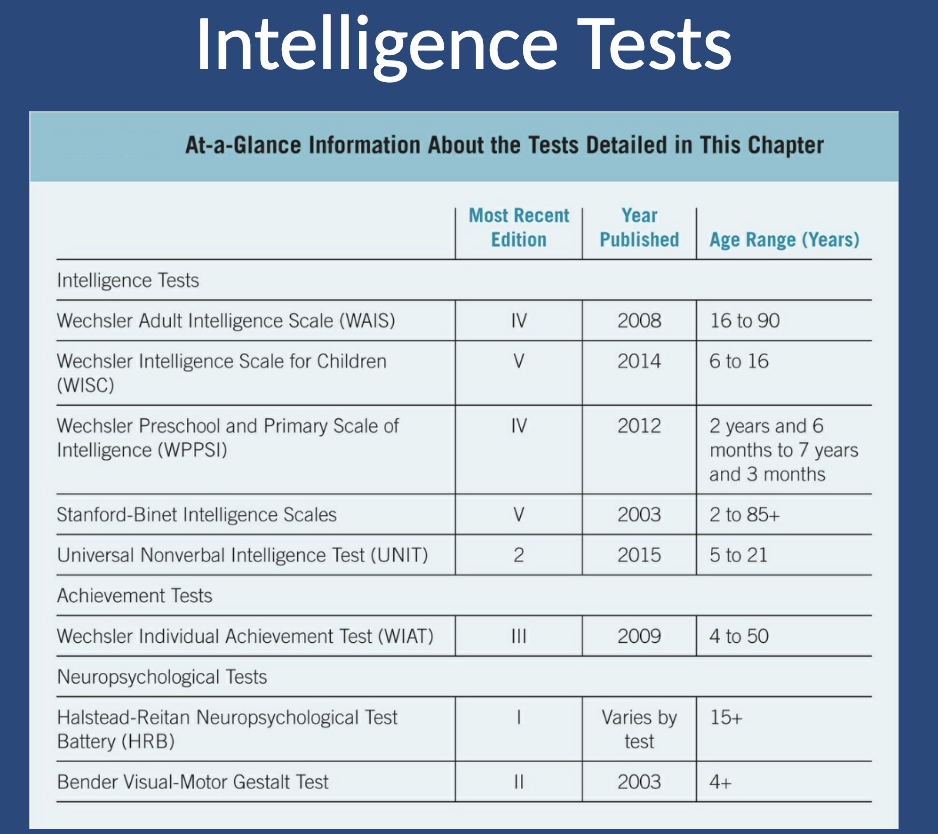
What is the heirarchial mode of intelligence in Wechsler Intelligence Tests? (Intelligence: Wechsler)
The Wechsler Intelligence Tests employ a hierarchical model of intelligence:
Single full-scale intelligence score: Reflects general, global intelligence (“g”).
Four or five Index scores and Subtest scores: Reflect increasingly specific areas of ability (“s”).
This structure allows clinical psychologists to focus broadly or narrowly when making interpretations about intellectual ability.
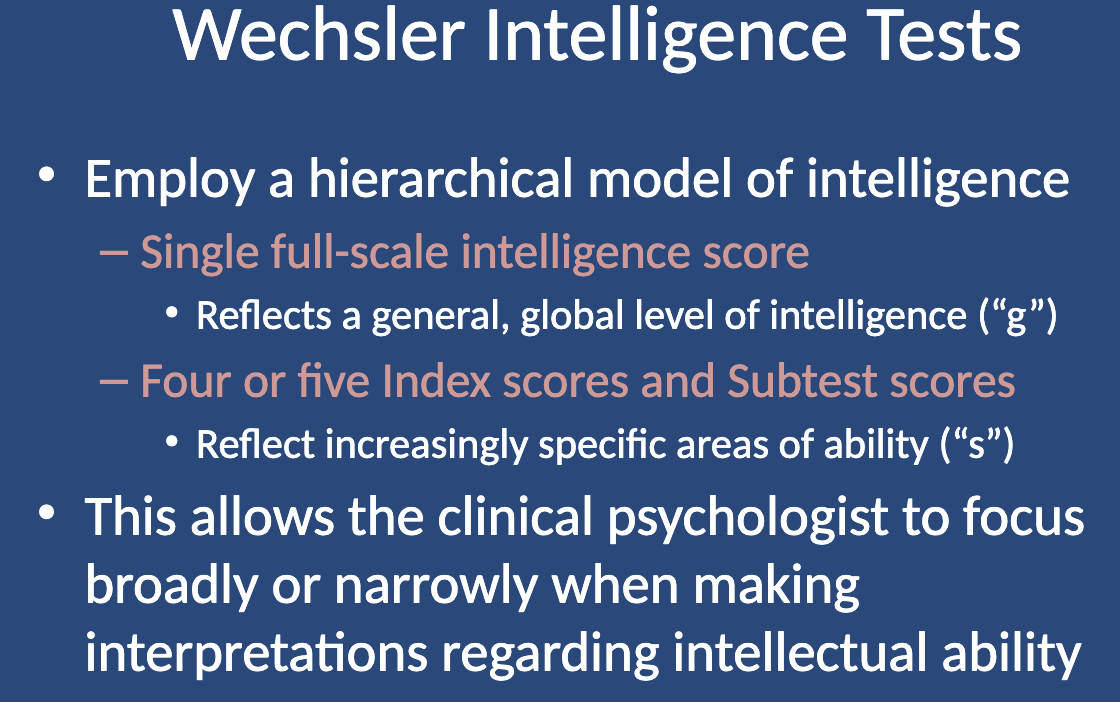
Single full-scale intelligence score (Intelligence: Wechsler)
Reflects general, global intelligence (“g”).
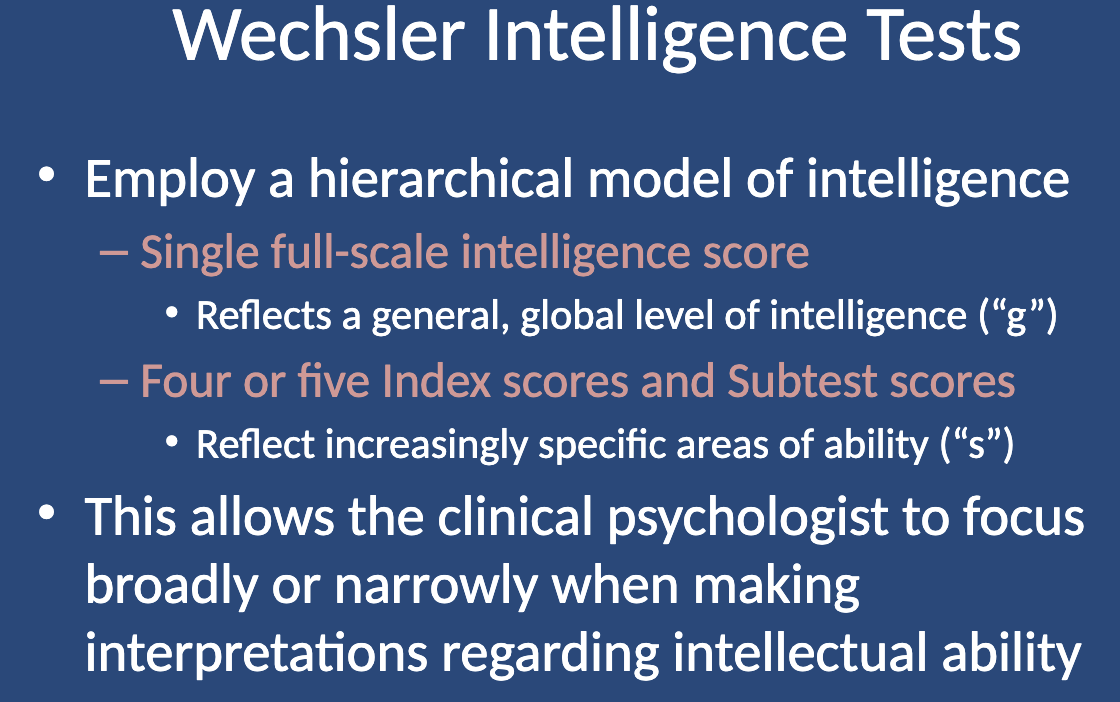
Four or five Index scores and Subtest scores (Intelligence: Wechsler)
Reflect increasingly specific areas of ability (“s”).
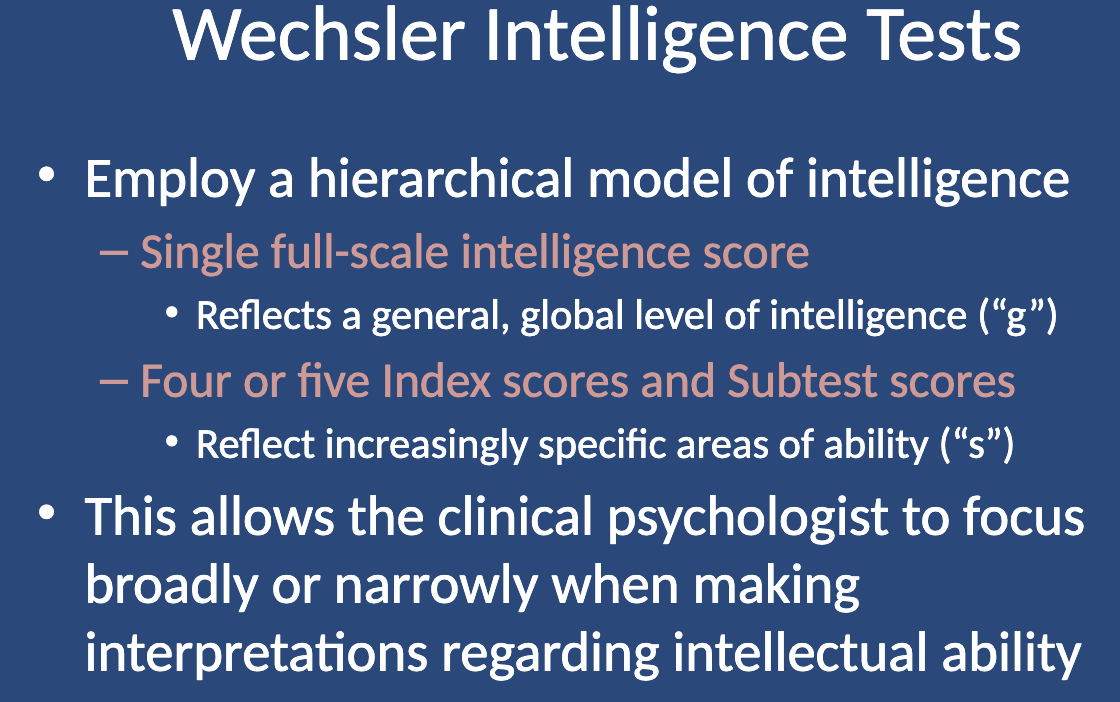
How are the Wechsler Intelligence Tests administered? (Intelligence: Wechsler)
Administered one-on-one and face-to-face—cannot be given to a group of examinees at the same time.
Not pencil-and-paper tests that examinees can do on their own (no multiple choice, true/false, or essay questions).
This administration is a structured interpersonal interaction that requires extensive training, typically received during graduate programs in clinical psychology.
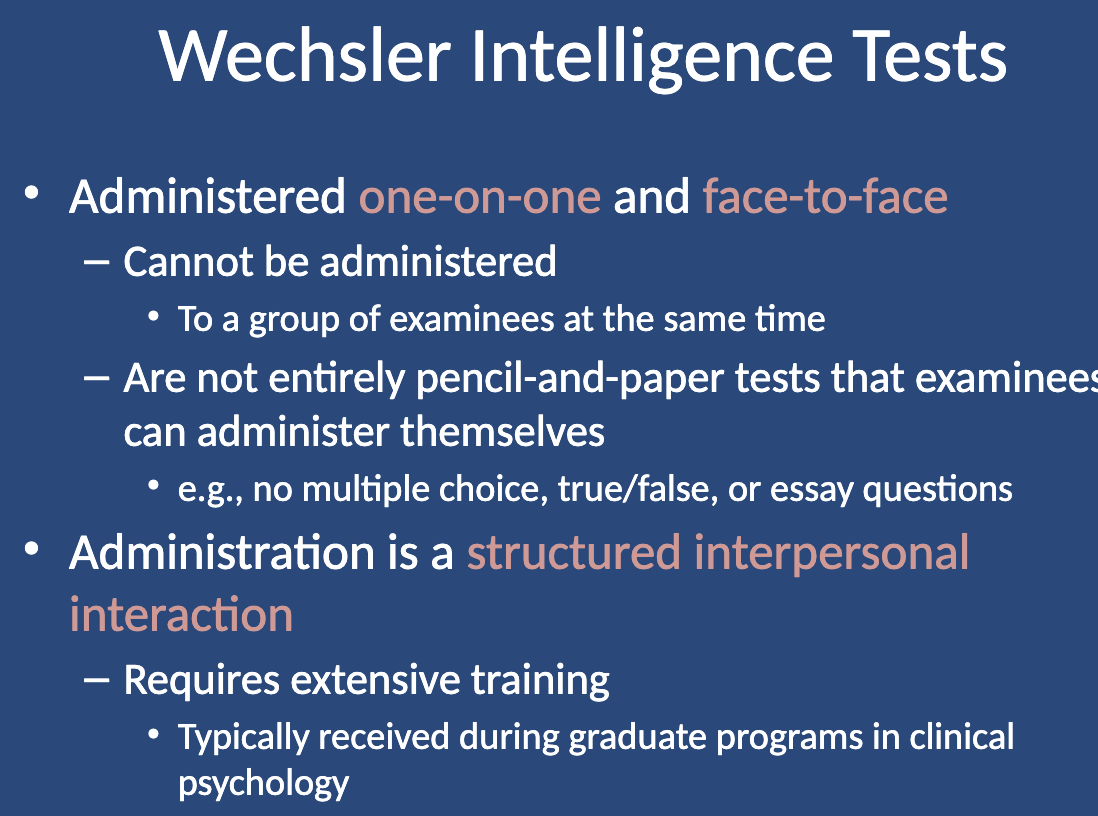
What is the structure of the Wechsler Intelligence Tests? (Intelligence: Wechsler)
Each subtest is brief, lasting about 2 to 10 minutes.
Subtests increase in difficulty as they progress, and examinees continue until they fail a predetermined number of consecutive items.
The tasks vary widely and include both verbal and nonverbal tasks.

What are the four factors of the Wechsler Intelligence Tests? (Intelligence: Wechsler)
Verbal Comprehension Index: Measures verbal concept formation and verbal reasoning.
Perceptual Reasoning Index: Assesses fluid reasoning, spatial processing, and visual-motor integration.
Working Memory Index: Evaluates the capacity to store, transform, and recall incoming information in short-term memory.
Processing Speed Index: Measures the ability to process simple or rote information rapidly and accurately.
(They were Originally designed only verbal and performance subtests (performance was equivalent to nonverbal). But now we have these four factors)
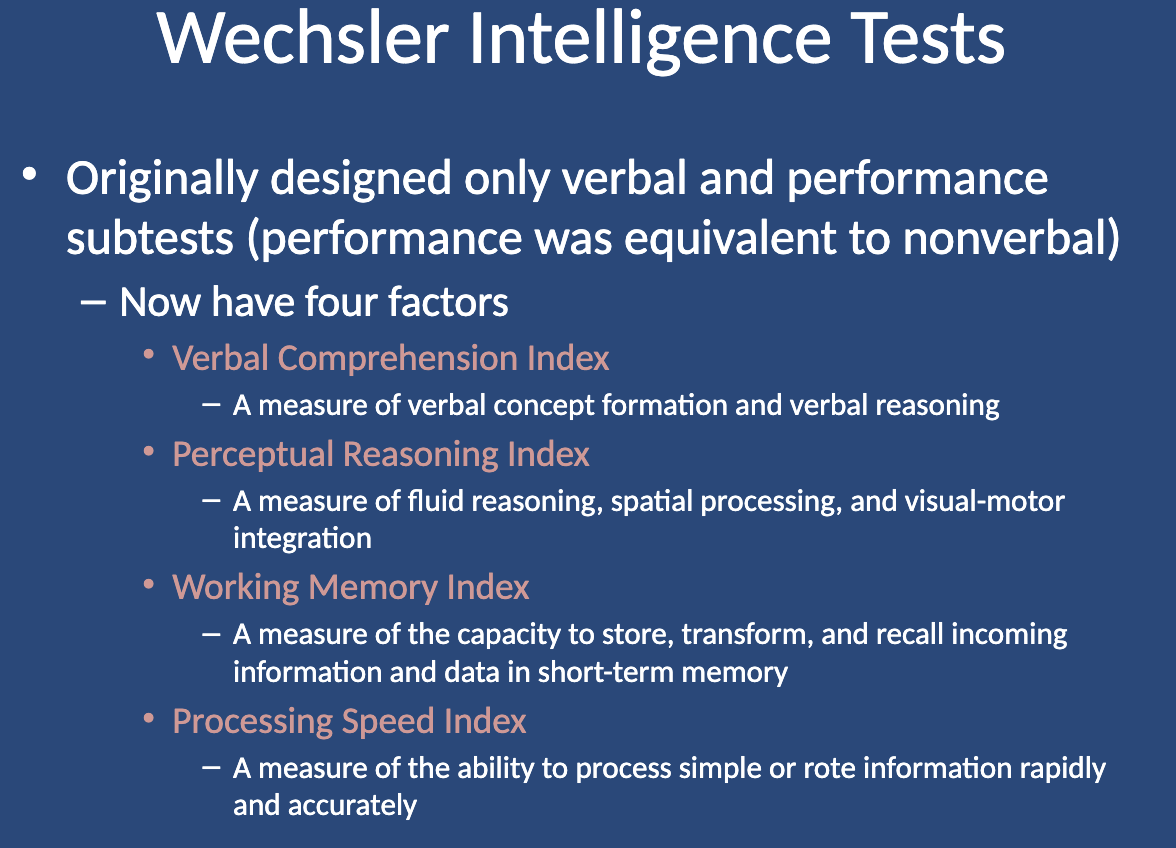
Normative Data (Intelligence: Wechsler)
a sample of test-result data gathered by creators of a psychological test and typically designed to accompany the test that constitutes a basis for comparison for individuals who take the test in clinical settings
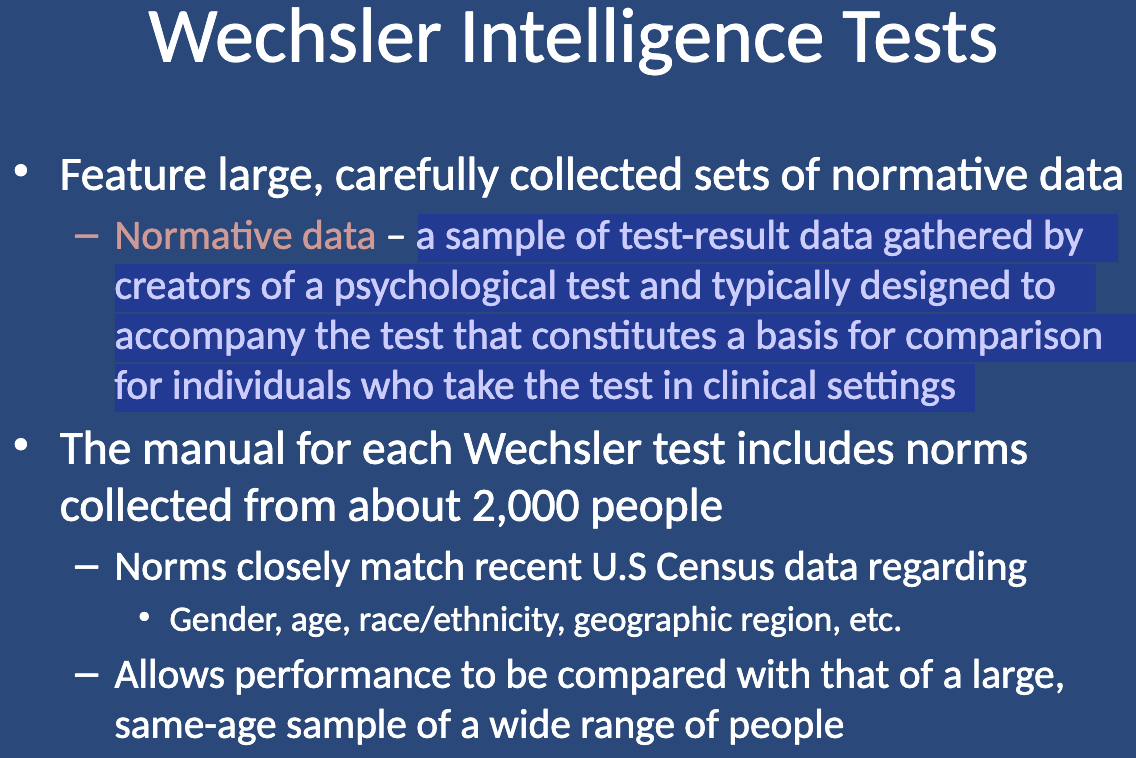
What is the role of normative data in the Wechsler Intelligence Tests? (Intelligence: Wechsler)
Normative data: A sample of test-result data gathered by test creators to serve as a basis for comparison.
Each Wechsler test includes norms from about 2,000 people.
The norms closely match recent U.S. Census data on gender, age, race/ethnicity, and geographic region.
This allows a person’s performance to be compared with that of a large, same-age sample of people from various backgrounds.

What do the full-scale and index scores represent in the Wechsler Intelligence Tests? (Intelligence: Wechsler)
The full-scale and index scores are IQ scores.
They reflect an intelligence quotient (IQ).
The examinee’s raw scores are compared with age-based expectations.
Mean IQ (of Full scale and Index) score: 100
Standard deviation: 15
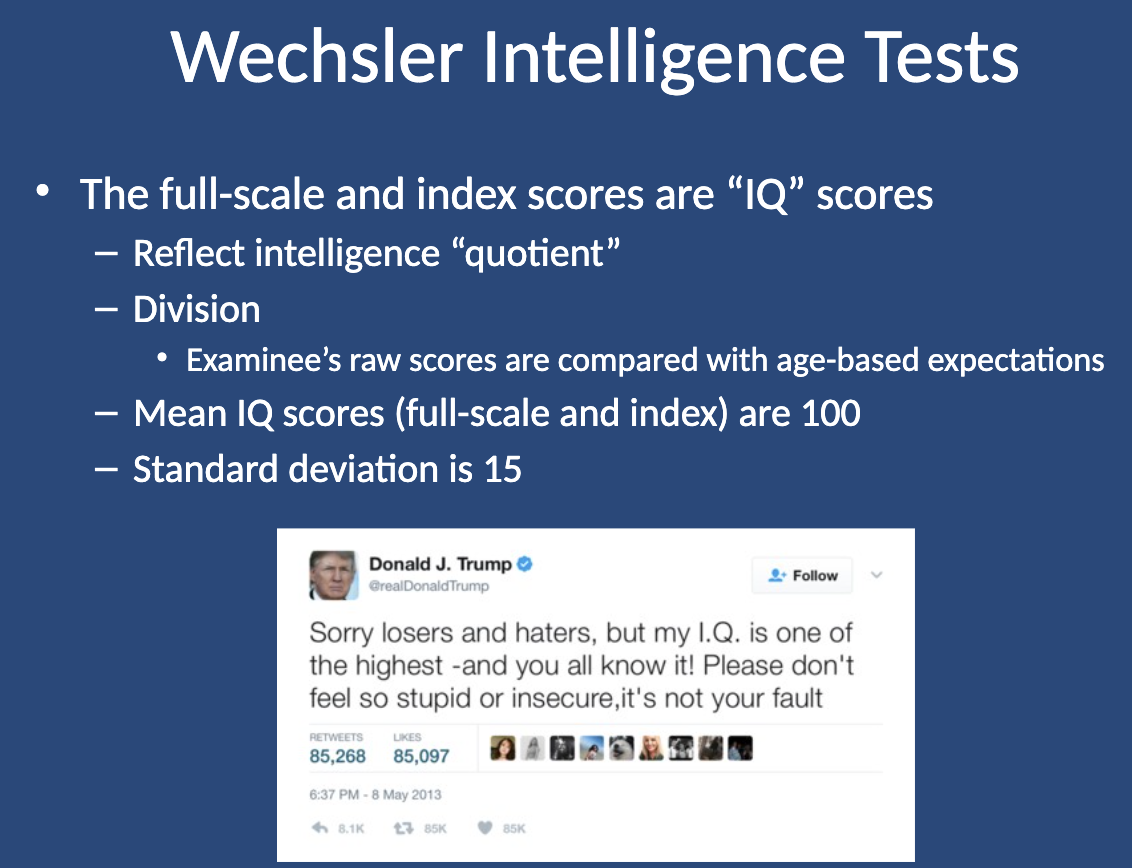
What is the general approach to interpreting scores in the Wechsler Intelligence Tests? (Intelligence: Wechsler)
First, consider the full-scale IQ score.
Next, interpret each index score in relation to the others, looking for relative deficiencies.
Finally, note details of testing, such as observable patterns of behavior that may have influenced performance (e.g., fatigue, anxiety, lack of motivation).
This approach of successive steps helps the assessor grasp the “big picture” before diving into the details.
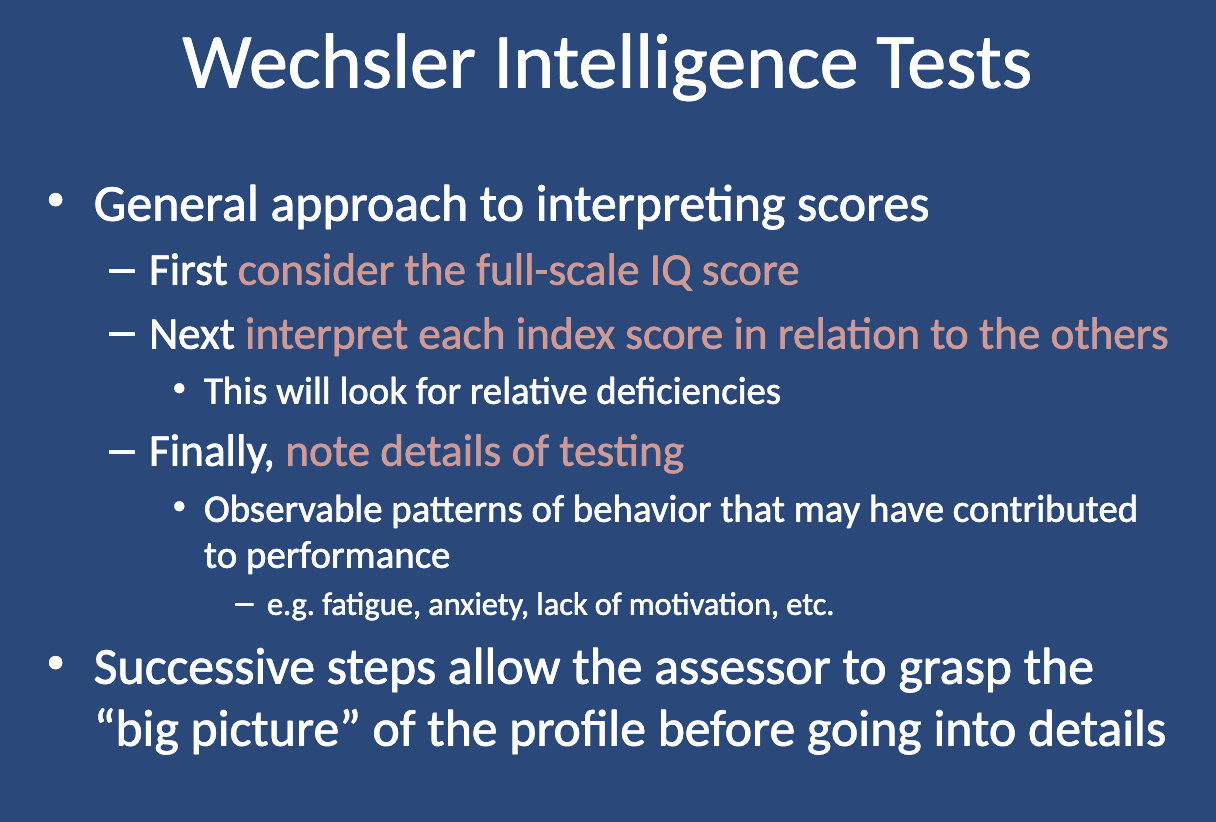
What are the specific contexts in which the Wechsler Intelligence Tests are used? (Intelligence: Wechsler)
Intellectual disability (intellectual developmental disorder)
Developmental delays
Giftedness
Educational and vocational planning
School placement and qualification
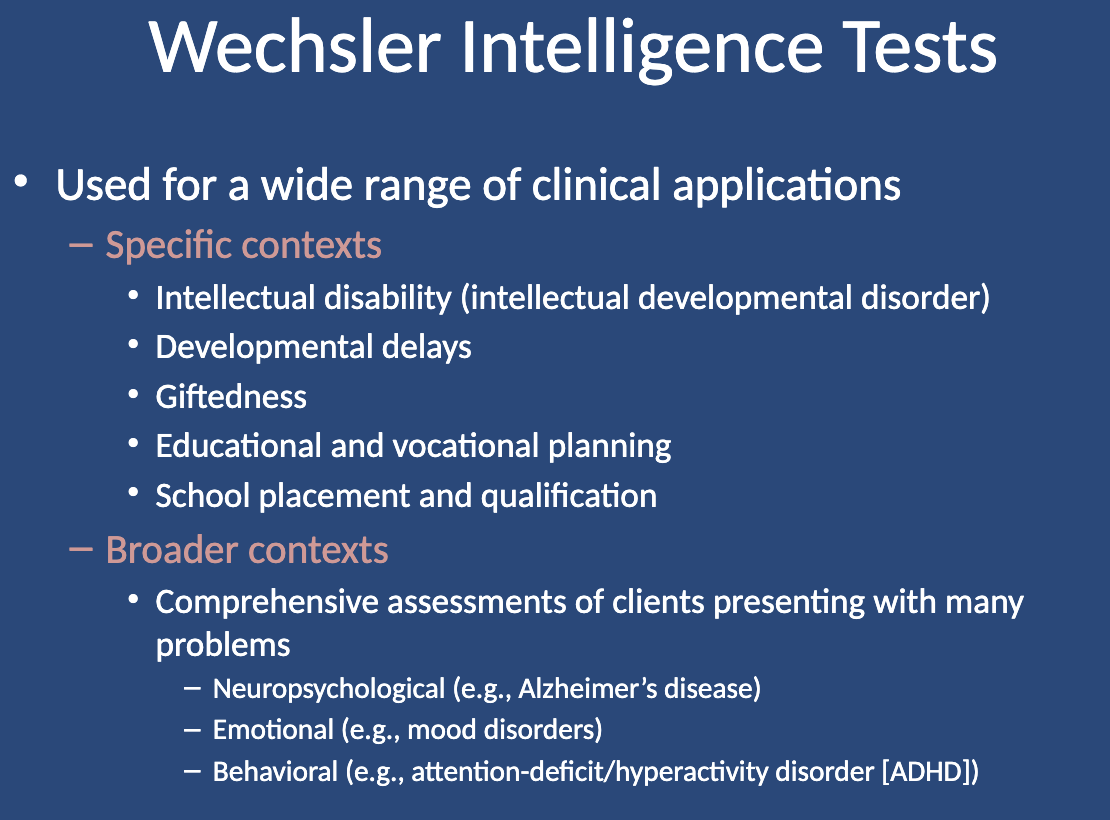
What are the broader contexts in which the Wechsler Intelligence Tests are used? (Intelligence: Wechsler)
Comprehensive assessments of clients presenting with various problems:
Neuropsychological (e.g., Alzheimer’s disease)
Emotional (e.g., mood disorders)
Behavioral (e.g., attention-deficit/hyperactivity disorder [ADHD])
![<ul><li><p>Comprehensive assessments of clients presenting with various problems:</p><ul><li><p>Neuropsychological (e.g., Alzheimer’s disease)</p></li><li><p>Emotional (e.g., mood disorders)</p></li><li><p>Behavioral (e.g., attention-deficit/hyperactivity disorder [ADHD])</p></li></ul></li></ul><p></p>](https://knowt-user-attachments.s3.amazonaws.com/4fc3e501-628c-4afc-86a6-650ef46ec347.png)
What are the strengths of the Wechsler Intelligence Tests? (Intelligence: Wechsler)
Impressive reliability and validity
Feature comprehensive and recent normative data
Cover an extremely wide age range
Provide full-scale, index, and subtest scores that have great clinical utility
Most psychologists are familiar with them
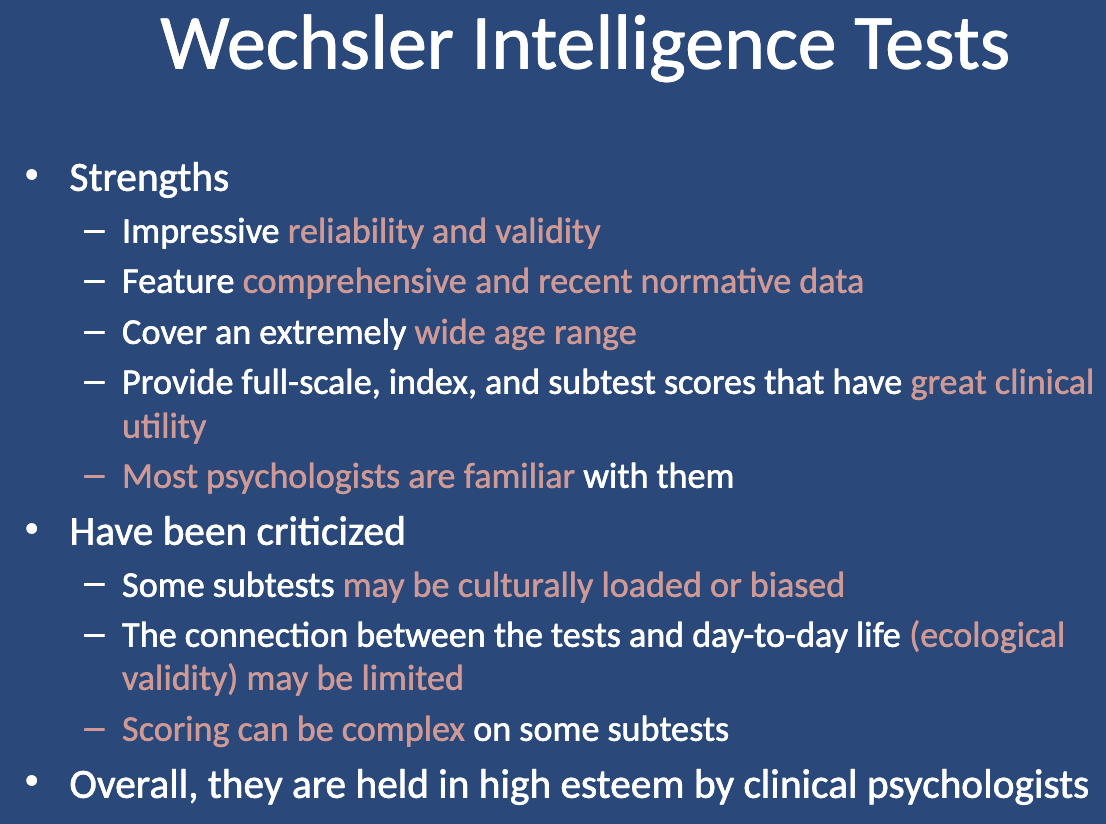
What are the criticisms of the Wechsler Intelligence Tests? (Intelligence: Wechsler)
Some subtests may be culturally loaded or biased
The connection between the tests and day-to-day life (ecological validity) may be limited
Scoring can be complex on some subtests
Despite these issues, they are still held in high esteem by clinical psychologists
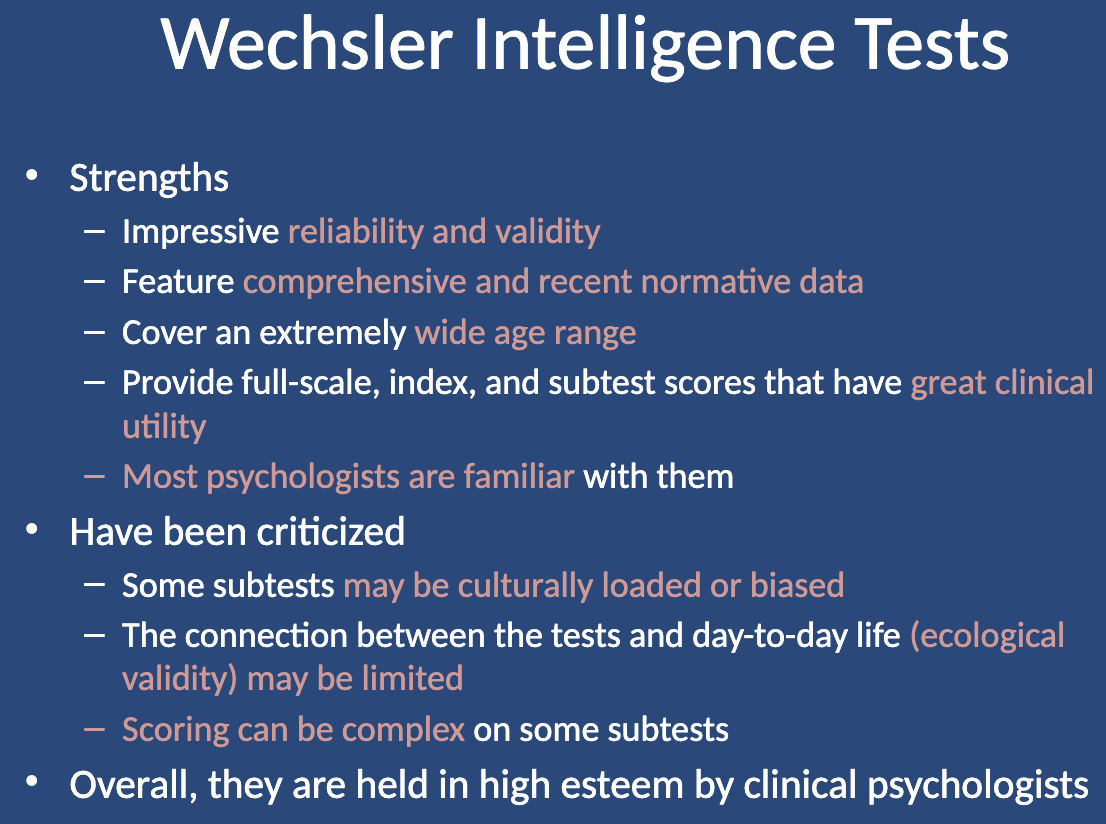
What are the Stanford-Binet Intelligence Scales? (Intelligence: Stanford-Binet)
The Stanford-Binet intelligence tests have a rich history, dominating the field until the early 1900s.
Wechsler scales began providing competition in the field during that time.
The Stanford-Binet scales remain highly respected and offer an approach with similarities to and differences from the Wechsler tests.
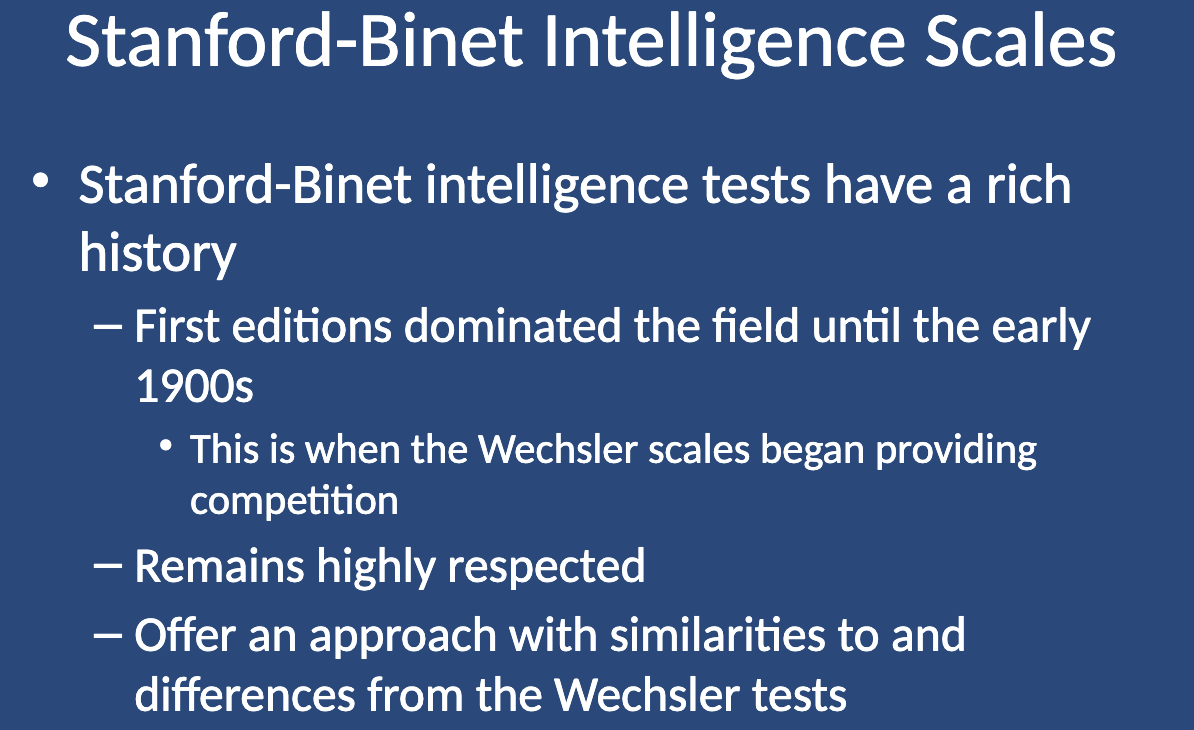
What are the similarities of the Stanford-Binet Intelligence Scales – Fifth Edition to Wechsler tests? (Intelligence: Stanford-Binet)
Administered face-to-face and one-on-one.
Employs a hierarchical model of intelligence.
Yields:
A singular measure of full-scale IQ (or “g”).
Five factor scores.
Many more specific subtest scores.
Features the same means (100) and standard deviations (15) as the Wechsler tests.
True for both full-scale and factor scores.
Psychometric data, including reliability and validity, are similarly strong.
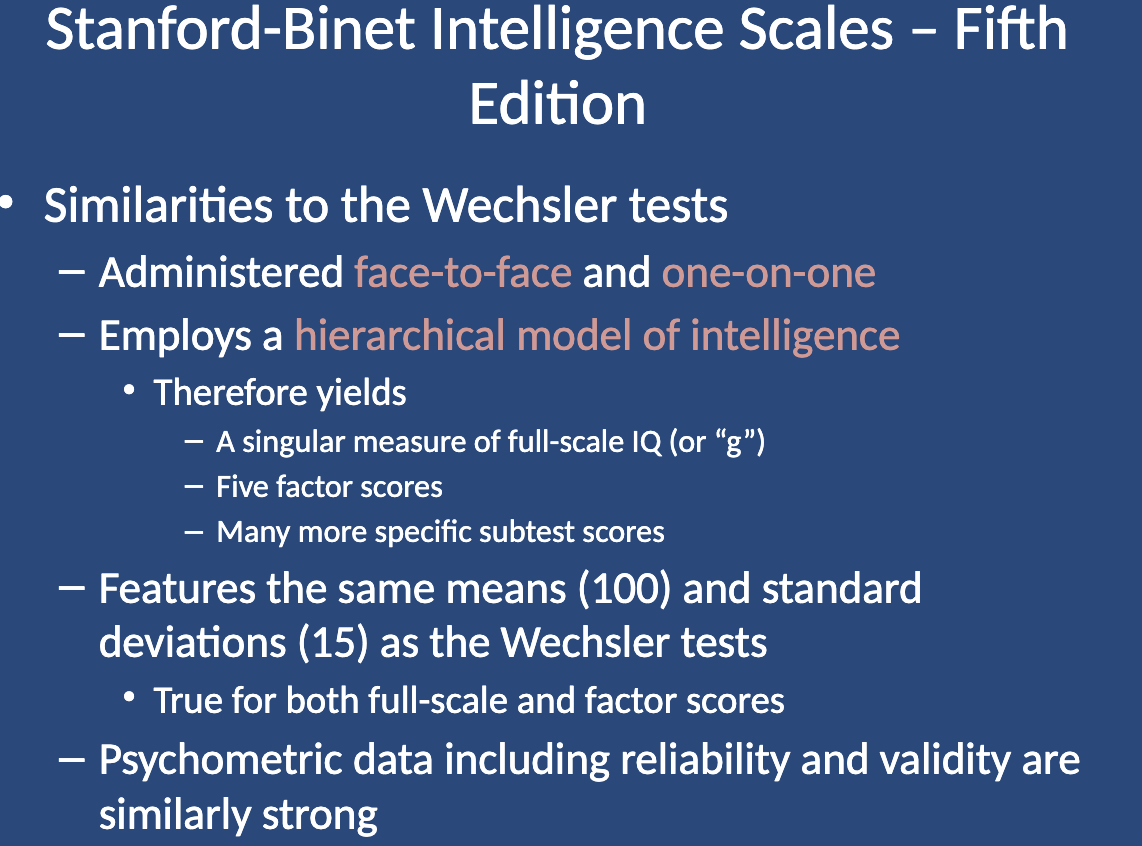
What are the differences between the Stanford-Binet Intelligence Scales – Fifth Edition and the Wechsler tests? (Intelligence: Stanford-Binet)
The Stanford-Binet covers the entire life span (ages 2-85+) as a single test, while there are three separate Wechsler tests for different age ranges.
Normative sample:
Like Wechsler, it has a normative sample that matches recent U.S. Census data on important variables.
Includes additional normative data from individuals with specific relevant diagnoses (e.g., learning problems, intellectual disability, ADHD).
Subtests include extensions on both the low and high ends, with a greater number of very easy and very hard items. This allows for more accurate assessment of individuals at the extremes, such as those with intellectual disabilities or who are gifted.
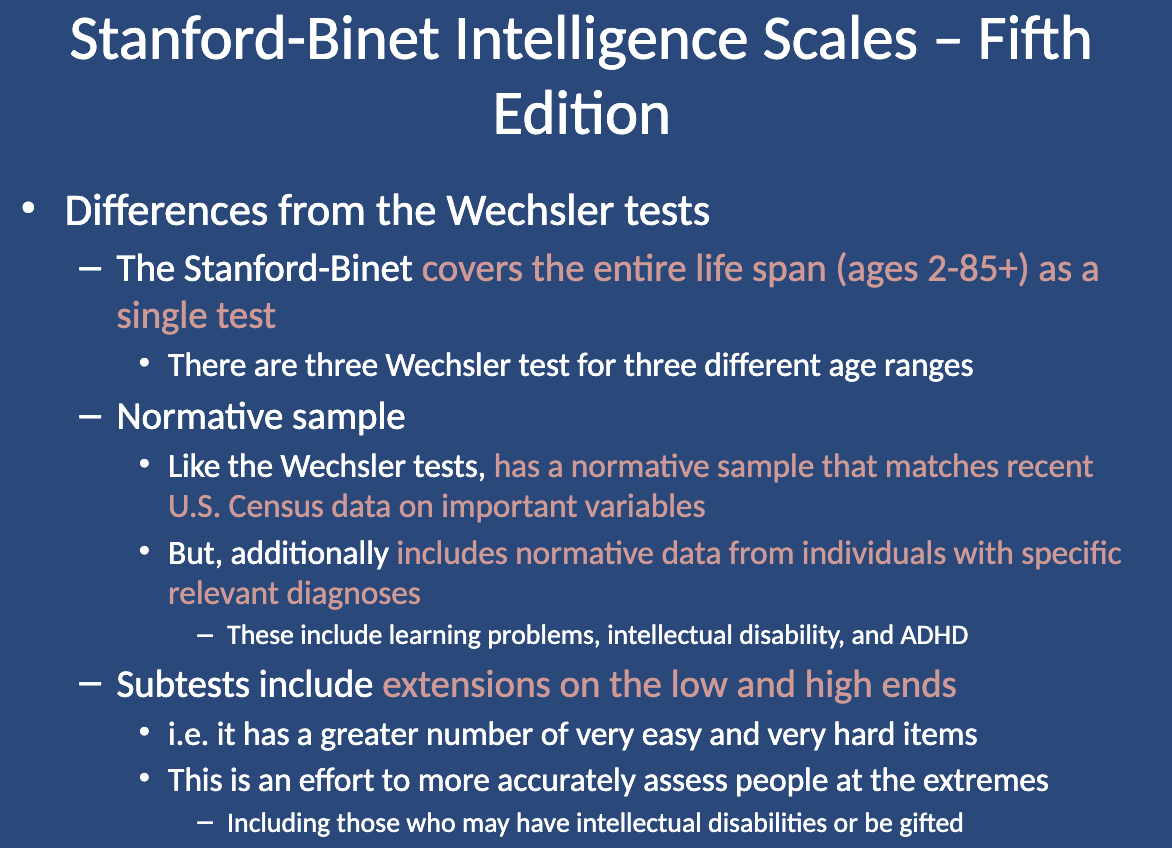
How do the the Stanford-Binet Intelligence Scales – Fifth Edition and the Wechsler tests differ in their specific factors and subsets? (Intelligence: Stanford-Binet)
Stanford-Binet:
Features five subtests:
Fluid Reasoning – Solving novel problems.
Knowledge – General information from personal experiences, education, and environment.
Quantitative Reasoning – Solving numerical problems.
Visual-Spatial Processing – Analyzing visually presented information.
Working Memory – Holding and transforming information in short-term memory.
Each subtest is measured both verbally and nonverbally.
Wechsler:
Features four or five factors that yield index scores, which measure more specific areas of cognitive ability.
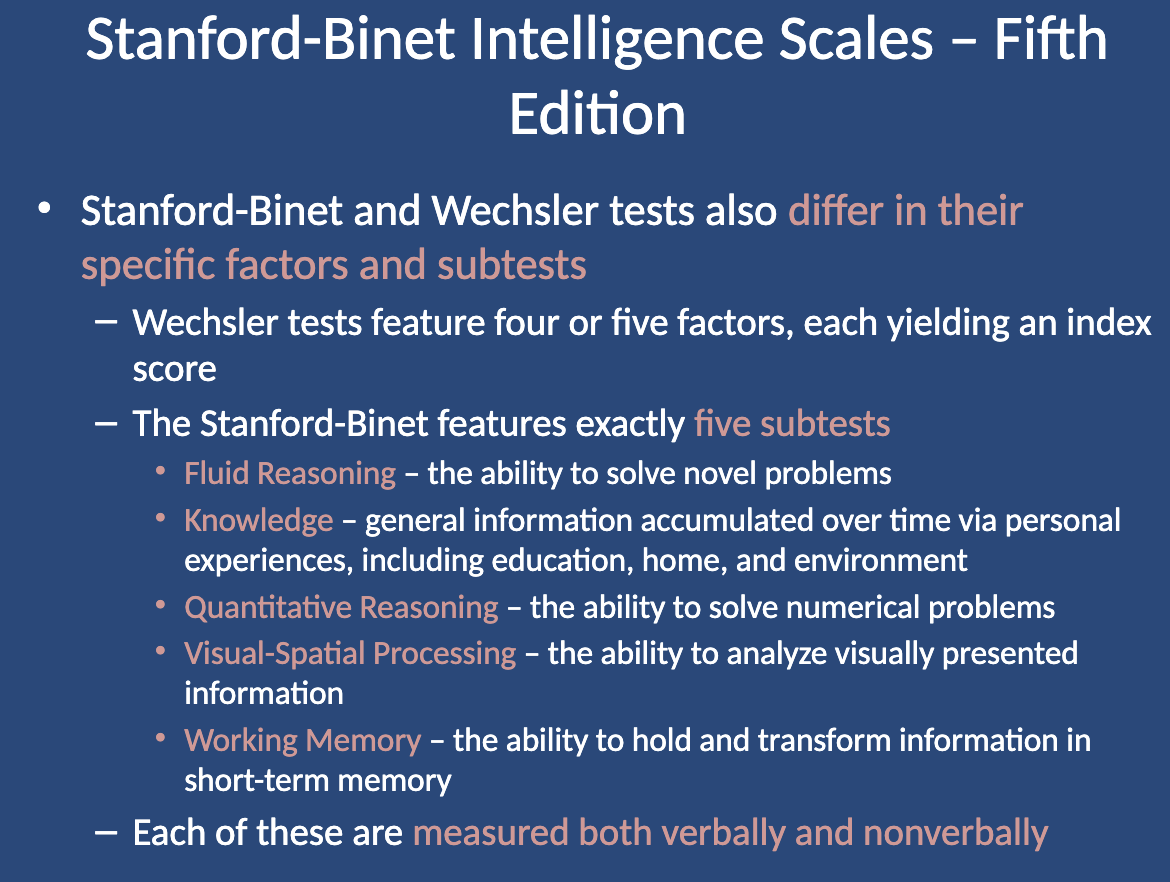
What did Schacter, Gilbert, and Wegner (2020) say about intelligence tests and their predictive value? (Intelligence: Test)
“You’ve probably heard people say things like, ‘IQ tests don’t predict anything important.’ That’s absolutely true – so long as you don’t think grades, jobs, money, health, or longevity are important.
The fact is that intelligence test scores are highly correlated with just about every outcome that human beings care about.”

What is a WAIS score? (Intelligence: Test)
A WAIS score is the result obtained from the Wechsler Adult Intelligence Scale, which assesses an individual's cognitive ability and provides an overall IQ score along with index scores for various cognitive domains.
How do WAIS scores relate to income? (Intelligence: Test)
Predict a wide variety of important life outcomes, including being an excellent predictor of income.
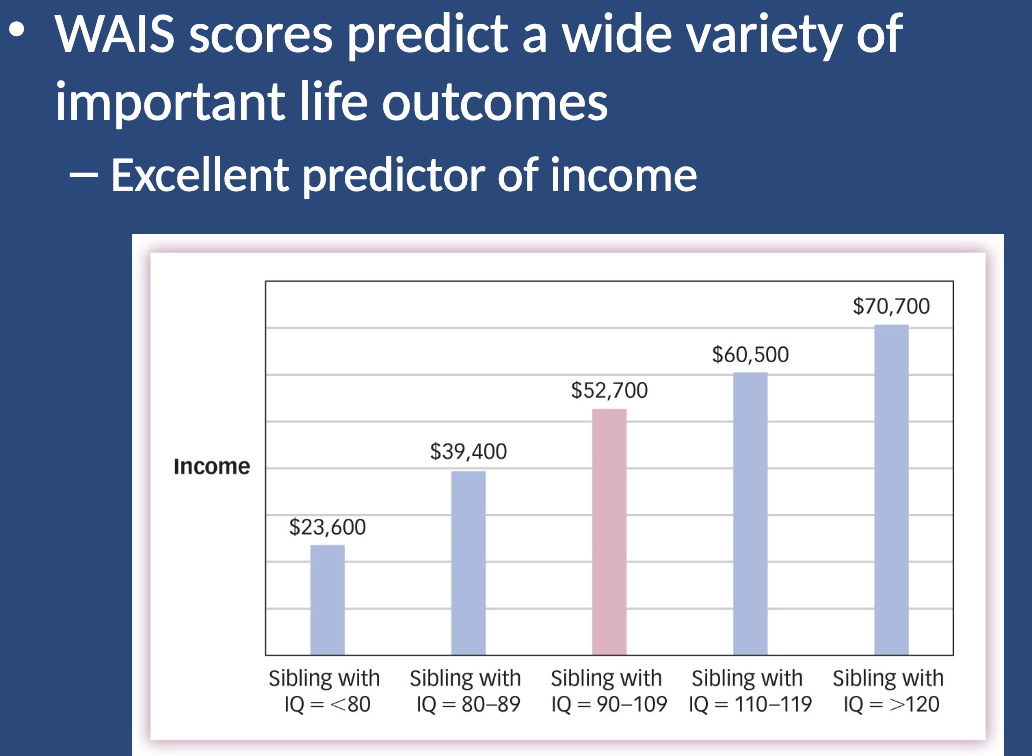
How do WAIS scores relate to education? (Intelligence: Test)
IQ is a stronger predictor of the amount of education a person will receive than social class.
Intelligent people tend to spend more time in school and perform better when they’re there.
Correlation between IQ and academic performance: r = .50.
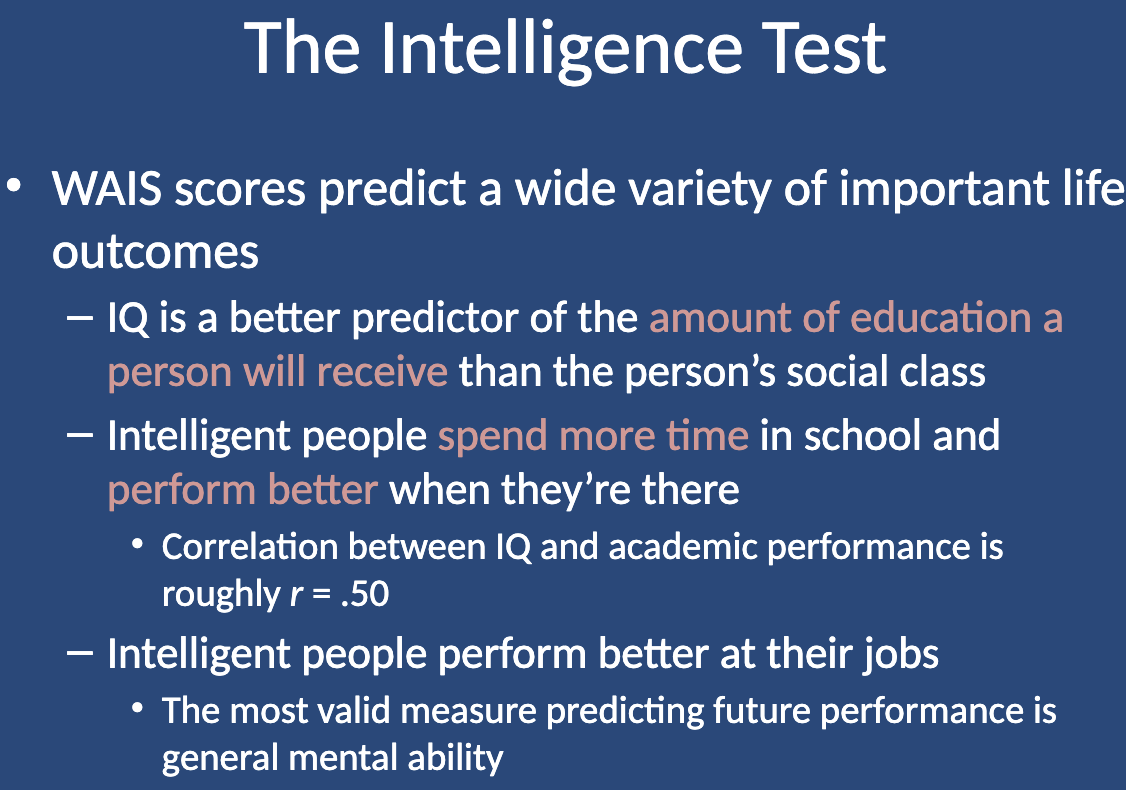
How do WAIS scores relate to jobs? (Intelligence: Test)
Intelligent people perform better in their jobs.
General mental ability is the most valid measure predicting future job performance.

How do WAIS scores relate to health? (Intelligence)
Intelligent people aren’t just wealthier, they are healthier too
Strong correlation between intelligence and both health and longevity
Intelligent people are less likely to smoke or drink alcohol
Intelligent people are more likely to exercise and eat well
Intelligent people live longer
Every 15-point increase in a young person’s IQ is associated with a 24% decrease in their risk of death from various causes (e.g., cardiovascular disease, suicide, homicide, accidents).
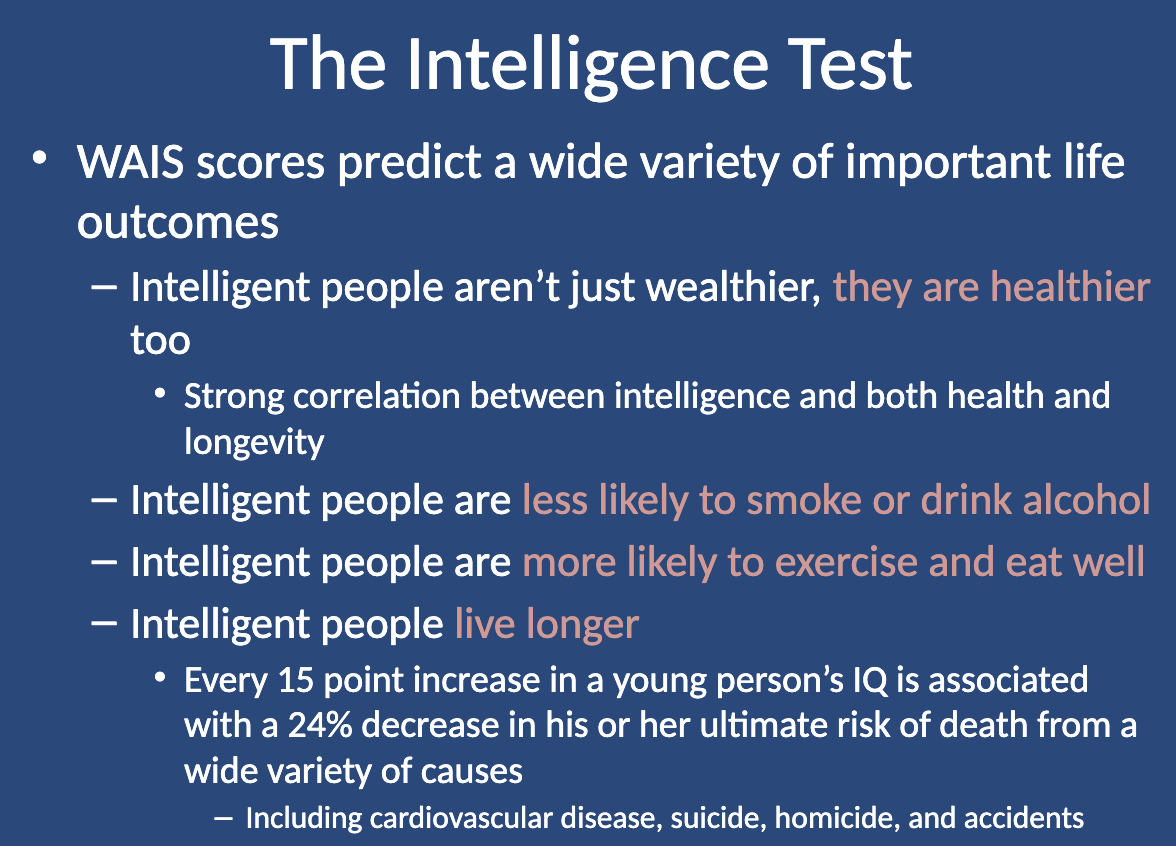
How do WAIS scores relate to sociability? (Intelligence)
Those with higher IQs
Have more satisfying relationships and better mental health
Tend to be less racist, less sexist, less likely to commit crimes
Are more attentive to the benefits of long-term cooperation and less tempted to exploit others
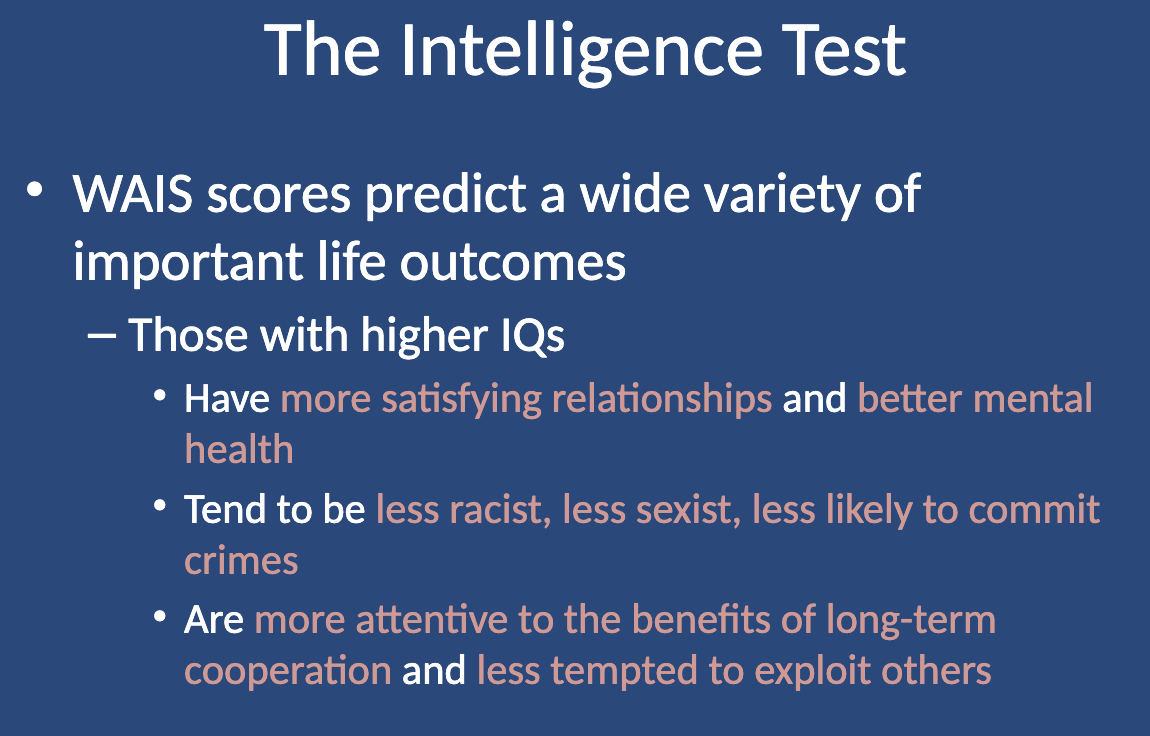
What do studies suggest about high IQ and life outcomes? (Intelligence)
Williams et al. (2017): High IQ is only associated with one bad trait—bad eyesight.
Deary, Pattie, & Starr (2013): A study of Scottish 90-year-olds showed that IQ scores from childhood are highly predictive of intelligence in old age.
Kell, Lubinski, & Benbow (2013): Children in the top 1% of verbal and mathematical skills were more likely to become scientists, journalists, politicians, CEOs, and leaders in society 20 years later.
Lubinski, Benbow, & Kell (2014): Top 1% mathematical reasoning at age 13 predicted future success as attorneys, executives, and professors. These individuals were more likely to write books, secure patents, and excel in their fields.
IQ tests are highly predictive of future success in life.
What is the difference between intelligence and achievement? (Intelligence v Achievement)
Intelligence refers to a person’s cognitive capacity – what they can accomplish intellectually
Achievement refers to what a person has actually accomplished, especially in subjects learned in school (e.g., reading, spelling, writing, or math).
Achievement tests typically produce age- or grade-equivalency scores and standard scores.
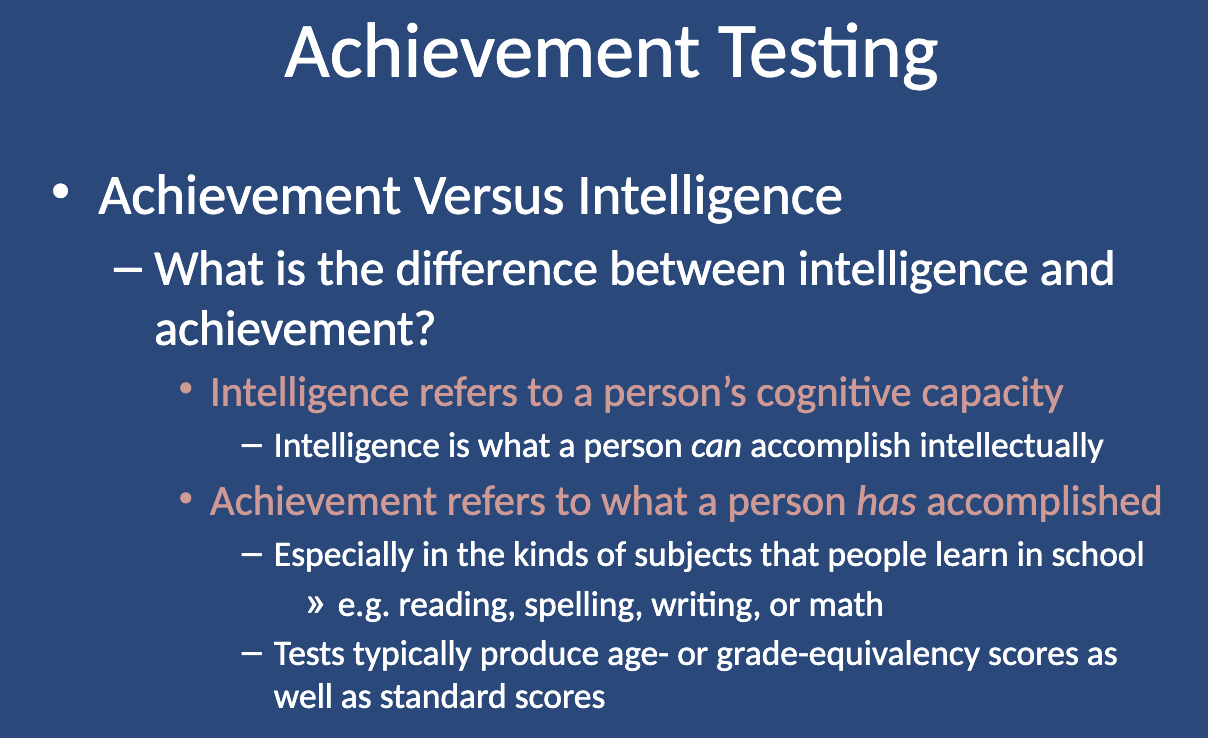
How has the terminology for learning disabilities changed in the DSM-5? (Achievement)
Prior to DSM-5, learning disabilities were determined by comparing intelligence and achievement.
In the DSM-5, the term "learning disability" has changed to Specific Learning Disorder.
The diagnosis is based primarily on the level of academic achievement falling significantly below expected levels of achievement for individuals of the same age.
Specific Learning Disorder (Achievement)
The diagnosis is based primarily on the level of academic achievement falling significantly below expected levels of achievement for individuals of the same age.
Was originally called a “learning disability” before DSM 5.
What are some examples of achievement tests and how do they vary? (Achievement)
Achievement tests come in many varieties:
Some measure a single area of achievement in detail (e.g., KeyMath, Gray Oral Reading Tests).
Some are more comprehensive, featuring a wide range of subtests:
Woodcock Johnson Tests of Achievement (WJ)
Wide Range Achievement Test (WRAT)
Kaufman Test of Educational Achievement (KTEA)
Wechsler Individual Achievement Test (WIAT)

What is neuropsychological testing and who practices it? (Neuropsychological)
is a specialized area within clinical psychology, practiced by professionals with extra training in neuropsychology.
This additional training typically occurs during:
Graduate school
Predoctoral internship
Postdoctoral internships
The intent of neuropsychological tests is to measure cognitive functioning or impairment of the brain and its specific components or structures.

How do neuropsychological tests differ from medical procedures like CT, MRI, and PET scans? (Neuropsychological)
Medical procedures (e.g., CT, MRI, and PET scans) can show that part of the brain looks abnormal.
Neuropsychological tests show how that part of the brain is actually functioning.
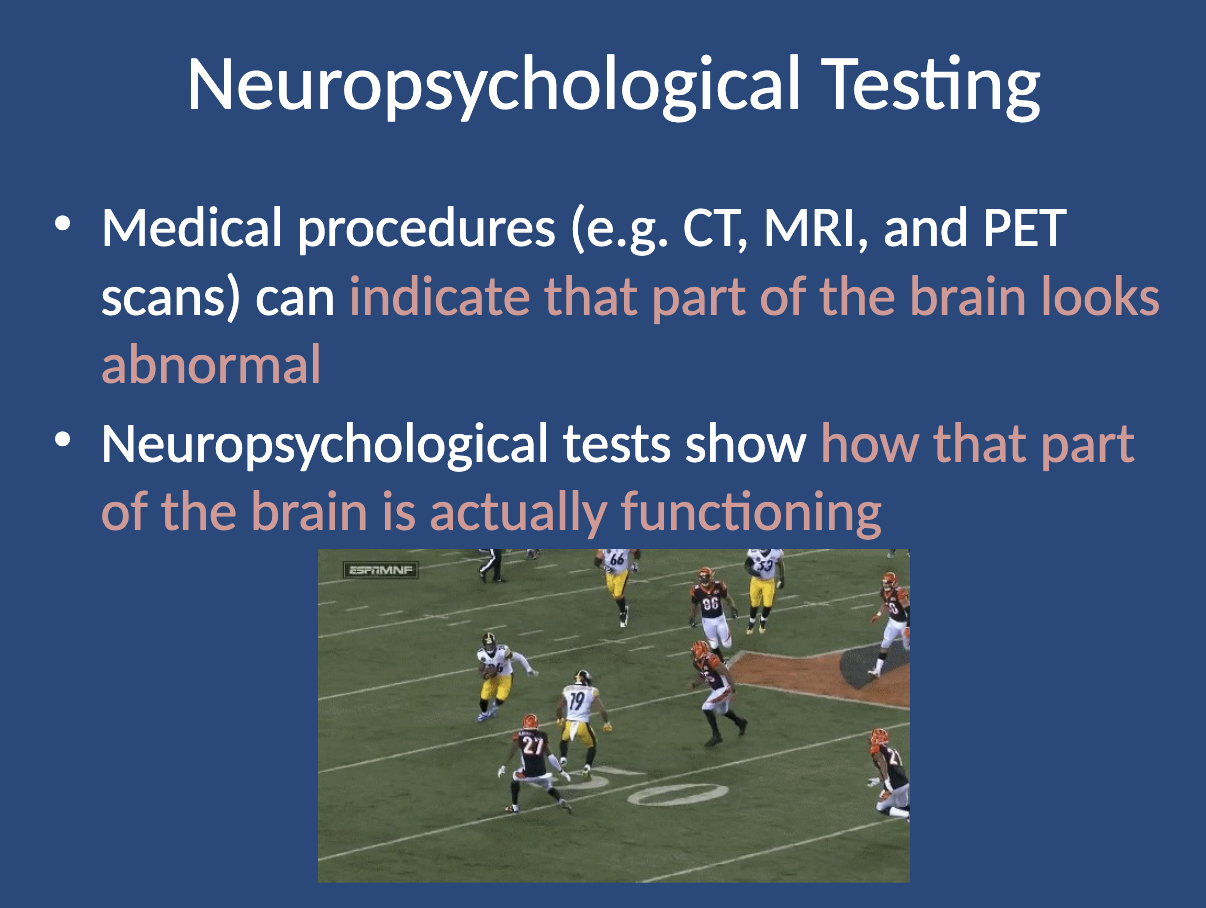
What are the uses of neuropsychological testing? (Neuropsychological)
Targeted assessment of problems from:
Head injury
Prolonged alcohol or drug use
Degenerative brain illness
Applications include:
Prognosis for improvement
Planning rehabilitation
Determining eligibility for school or work accommodations
Establishing a baseline for future comparisons
